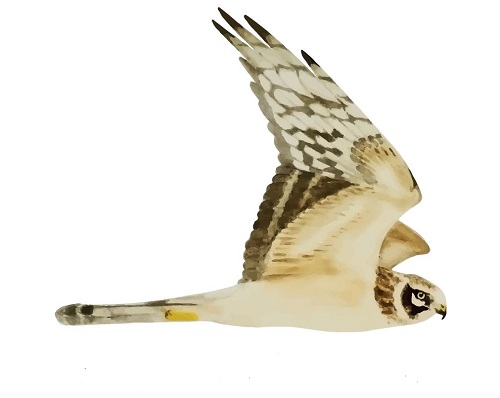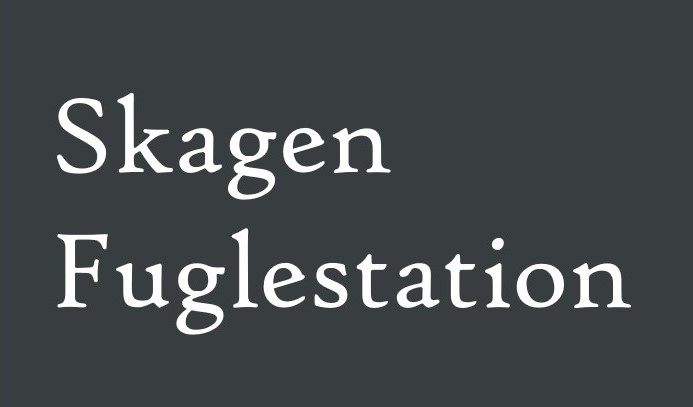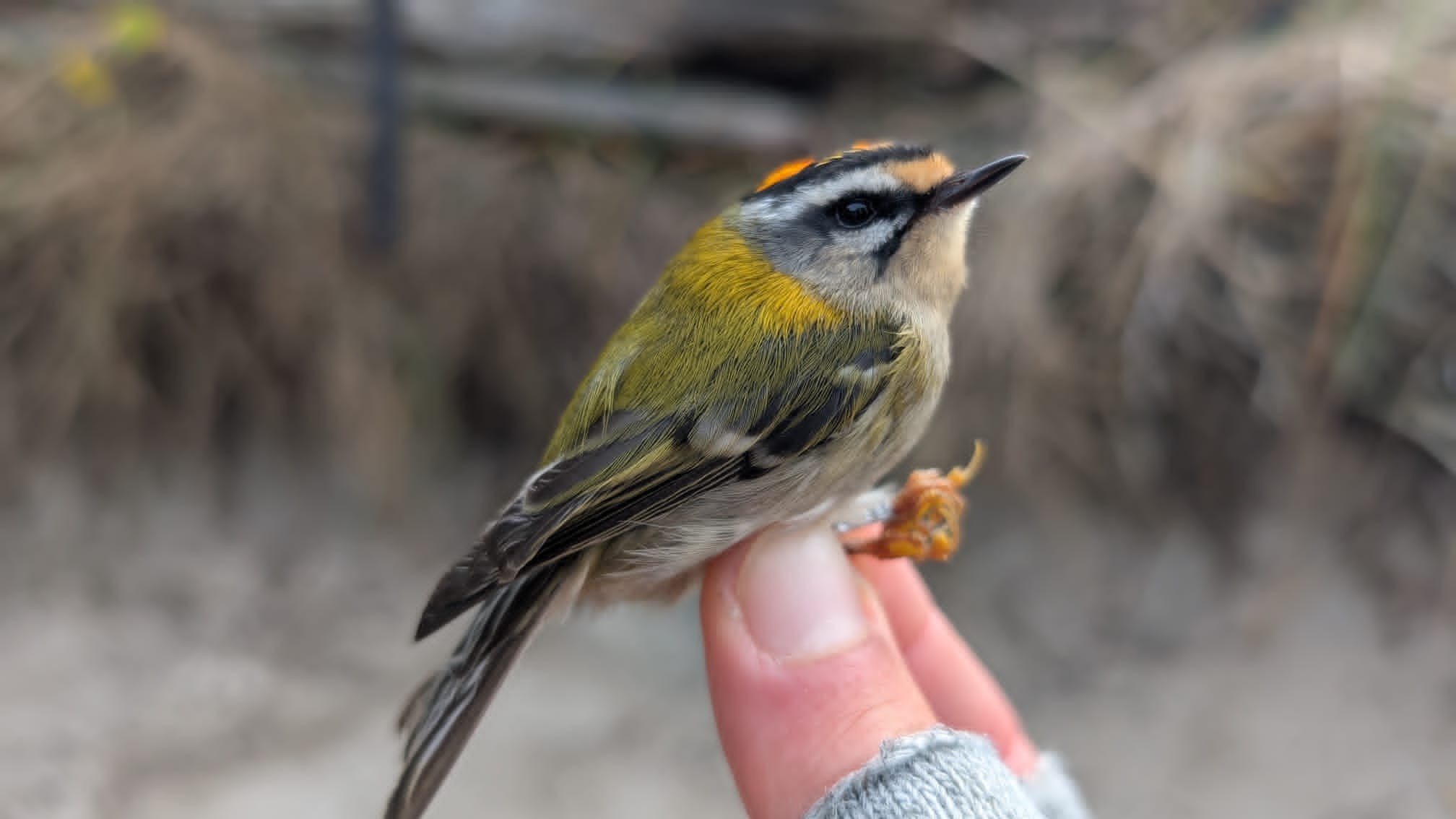Her på Skagen Fuglestations blog bringes korte nyheder i dagbogsformat om hændelser på fuglestationen.
Rainy morning
The weather forecast did not look promising for ringing and observation today. So we decided to sleep in today, which everyone really enjoyed. After this nice start, we didn't want to just hang around being lazy, but wanted to do some useful work. So we checked all the remaining ringing sheets from the previous days for mistakes.
Since we couldn't be at World's End 3 in the cold this morning, Miles and I decided to go out into the cold in the afternoon. We went to Frederikshavn to search for the long-staying Kentish plover (Hvidbrystet Præstekrave). When we arrived, we heard from another birder that many of the waders present had just been flushed far to the north by a dog. Then the waiting began until he would return. Even without the plover, birding was fun there. The longer we waited, the more birds arrived. About 150 Dunlins (Almindelig Ryle), 35 Redshanks (Rødben), 30 Oystercatchers (Strandskade) and some Shore Larks (Bjerglærke) were nice to see. Even though the cold wind made us feel really cold, we stayed there for a long time. Unfortunately, the Kentish plover did not reappear, so we returned to Skagen without having seen it.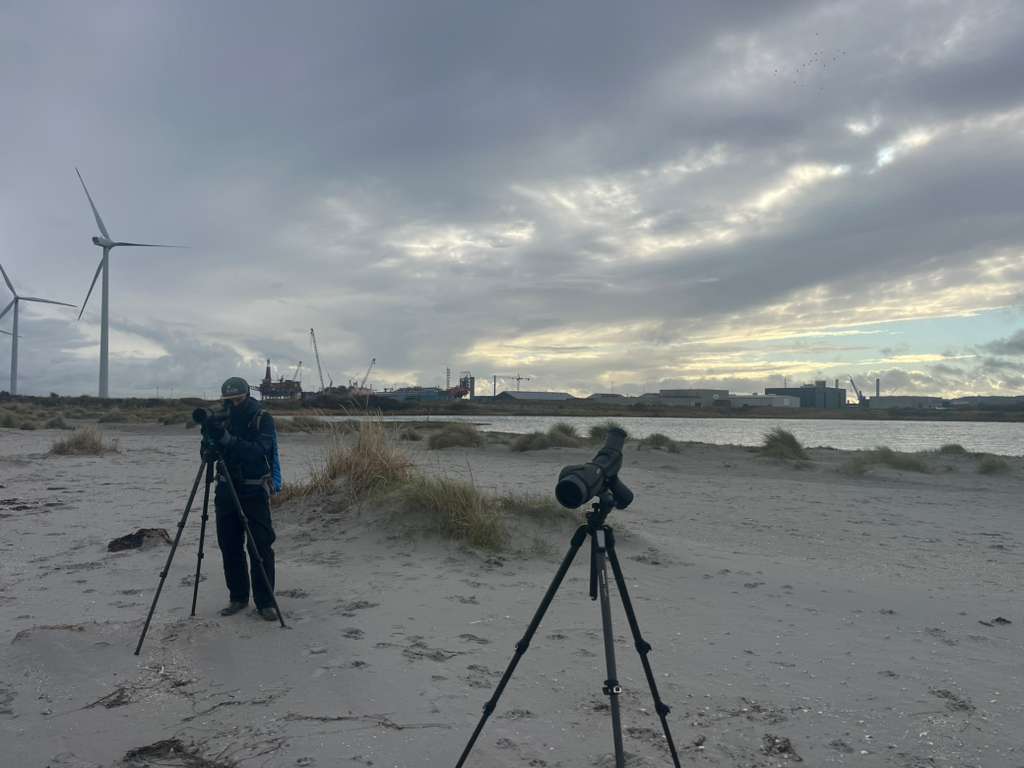
Searching the Kentish Plover (Hvidbrystet Præstekrave) in Frederikshavn
Knud had also been outside in the afternoon for some ‘gulling’ at Grenen. He was successful and managed to find a total of seven Caspian Gulls (Kaspisk Måge)! However, the Baltic lesser black-backed gull (Baltisk Sildemåge) seemed to have disappeared.
Miles used the evening to finish an exciting graphic for our big ringing day on 6 October. It shows how many individuals of the different species were ringed at what time of the day. At the same time, Amira prepared a delicious dinner for us and we listened to german banger songs!
No ringing today
Highlights from the observation
Kaspisk Måge (Caspian Gull) 7
Today's observations from the area can be seen here.
People: Mara Glane, Florian Hatt, Amira Nuseibeh, Miles Scheuering, Lise Mastrup, Simon S. Christiansen and our guests Lars and Lone
Hale og skæg
Observatørerne havde en stille dag ved Verdens Ende 3 med kun lidt aktivitet over havet. Morgenen bød dog alligevel på rider (kittiwake), nogle få alkefugle (auk) og en søkonge (little auk). Morgenobservationens måske mest bemærkelsesværdige fugl blev dog ikke set, men hørt. Identiteten af denne fugl er vi endnu ikke sikre på, men en lidt uskarp lydoptagelse fortæller, at det muligvis har været en sibirisk vipstjert (eastern yellow wagtail). Forhåbentligt ved vi inden længe, om det er denne eller anden art, som har været forbi. Under morgenobservationen blev der desuden spottet silkehaler (waxwing), som vi også havde glæde af at se nogle af fra Kabeltromlen.
Dagens første netrunde gik relativt stille for sig, men heldigvis i selskab med skønne gæster i form af både fugle og mennesker. Amiras mor og fætter er på besøg i Skagen og sluttede sig til os ved Kabeltromlen, lige inden vi gik afsted på første runde. Da vi vendte tilbage, var det med blandt andet 11 skægmejser (bearded reedling), som vi alle var meget begejstrede for. På anden netrunde fik vi pludselig travlt med mange fugle i nettene og da vi mærkede en smule regn og kunne se radaren lovede mere på vej, måtte vi være effektive. Mens Mara og Lone ringmærkede, gik Amira og jeg (Lise) en runde igen med det samme, hvor vi også lukkede nettene. Dermed havde vi bedre overskud til at ringmærke de fugle, vi allerede havde rigeligt af og risikerede ikke, at nogle blev kolde og våde i nettene. Det gjaldt blandt andet halemejser (long-tailed tit), blåmejser (blue tit) og desuden 3 rødtoppede fuglekonger (firecrest). Dermed fik vi en lidt kortere ringmærkningsdag end forventet, men på trods af dette et godt antal fugle med en fin artsdiversitet.
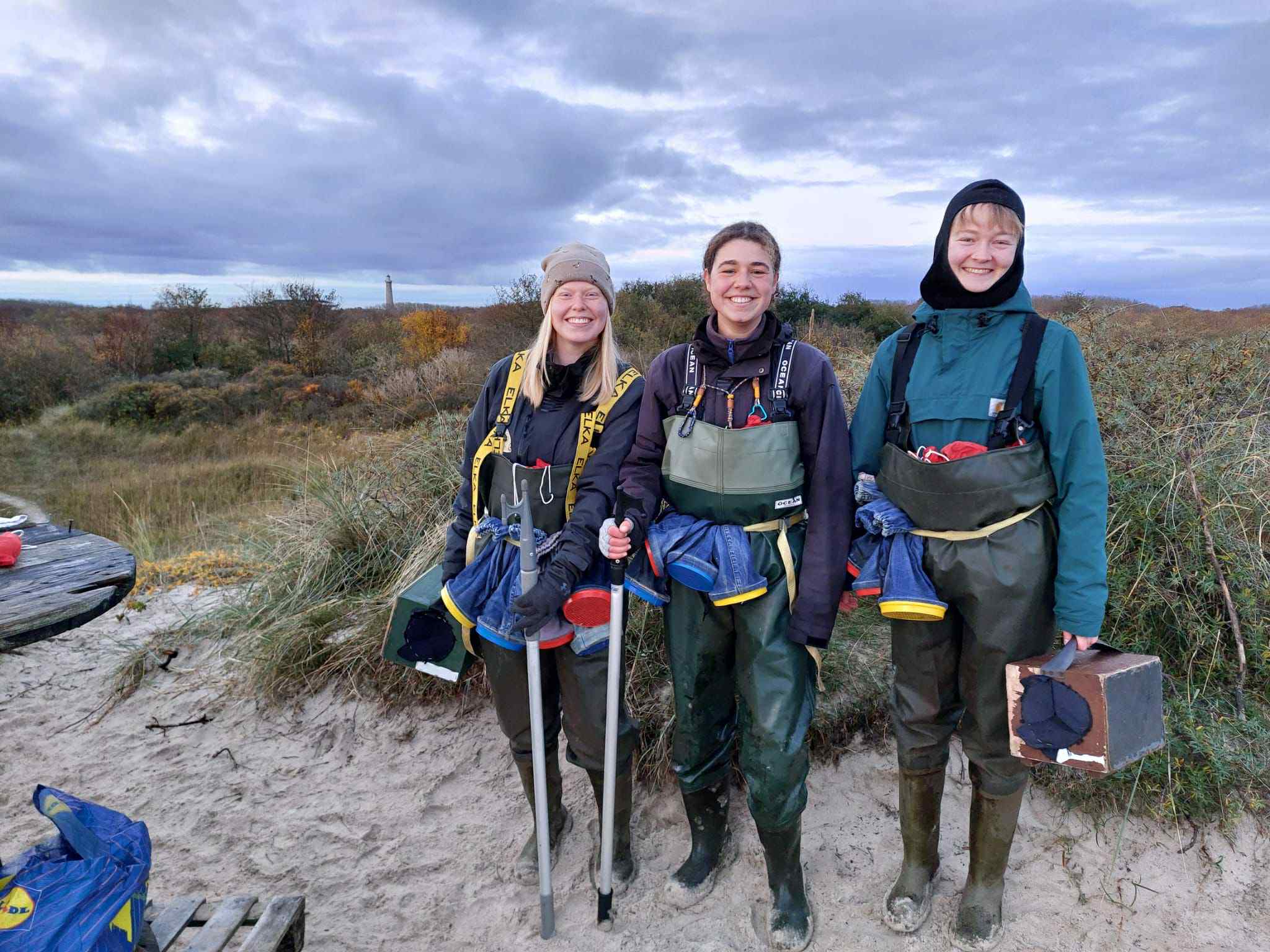 Tre ringmærkere klar til dagens strabadser. Foto af Amiras mor.
Tre ringmærkere klar til dagens strabadser. Foto af Amiras mor.
Eftermiddagen gik med dataindtastning, indkøb og andre praktiske opgaver. Mellem regnbygerne gik både Mara og Florian en tur, hvor de hver især så halemejser (long tailed tit). Mara så nogle med ringe, som måske har været dem fra i dag og Florian så nogle uden. Måske vi får besøg af dem i nettene en anden dag.
En anden spændende opdatering herfra er, at vi har fået melding om genfangst af en rødhals (robin), som blev ringmærket ved Kabeltromlen den 1. oktober. Den blev genfanget ved Ketelmeer, nær byen Swifterbant i Holland den 18. oktober. Det må betyde, at den er godt på vej sydpå.
Potentiel Sibirisk vipstjert (Potential Eastern Yellow Wagtail) 1
Dagens observationer fra Grenen kan ses her.
Folk på stationen: Mara Glane, Florian Hatt, Amira Nuseibeh, Miles Scheuering, Lise Mastrup, Simon Christiansen, Ole and Anton, and our guests Lars and Lone
Fantastisk Birthday
Today is my birthday and when I woke up and walked into the kitchen, Florian and Janna sang happy birthday to me and presented me with my birthday card. The ringers had forgotten the paint for the new kabeltromlen, so dropped it off on my way to World’s End 3 and got another birthday serenade! I am told this was not planned. Janna left this morning to return to Germany. Her visit was far too short, but we are always happy to see her!
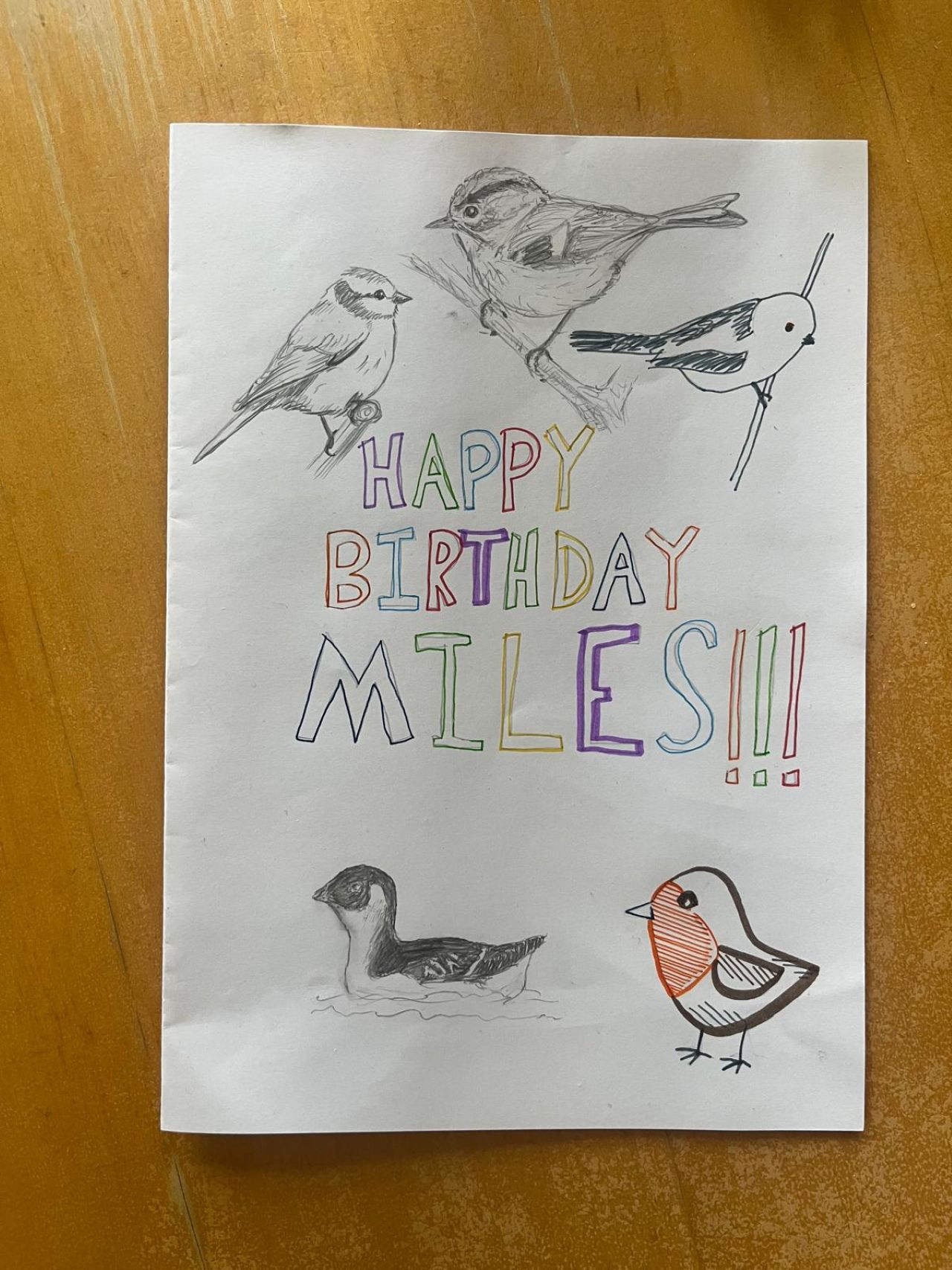
My birthday card made by the crew with a little auk (søkonge), robin (rødhals), northern long-tailed tit (nordlig halemejse), goldcrest (fuglekonge), and blue tit (blåmejse). Photo by Miles
Florian and I had a great morning at the migration count. Activity was good, with lots of black-legged kittiwakes (ride) and razorbills (alk). We had three little auks (søkonge), not as many as yesterday, but they are always cool to see. So cute and round! While checking the resting gannets (sule) in Kattegat, I spotted a tubenose (stormfugl) flying to the northwest. It was dark with pale patches on the underwings, a sooty shearwater (sodfarvet skråpe)! It was quite close and everyone got good looks, including Anton and Ole, who had just been discussing their interest in seeing one. It is a lovely birthday present to get a visit from the ‘King of Migration’ and I pleased to be the one to call it out. Other highlights were a lesser black-backed gull (sildemåge), that appeared to be of the Baltic subspecies (Larus fuscus fuscus), which is very rare here. Adults of this subspecies have a very dark mantle that blends into the wingtips and especially long wings, which makes them stand out. There are some finer points of the identification, to separate them from the variable intermedius but that is above my pay grade. We also saw a sand martin (digesvale), which I have not seen since 21 September!
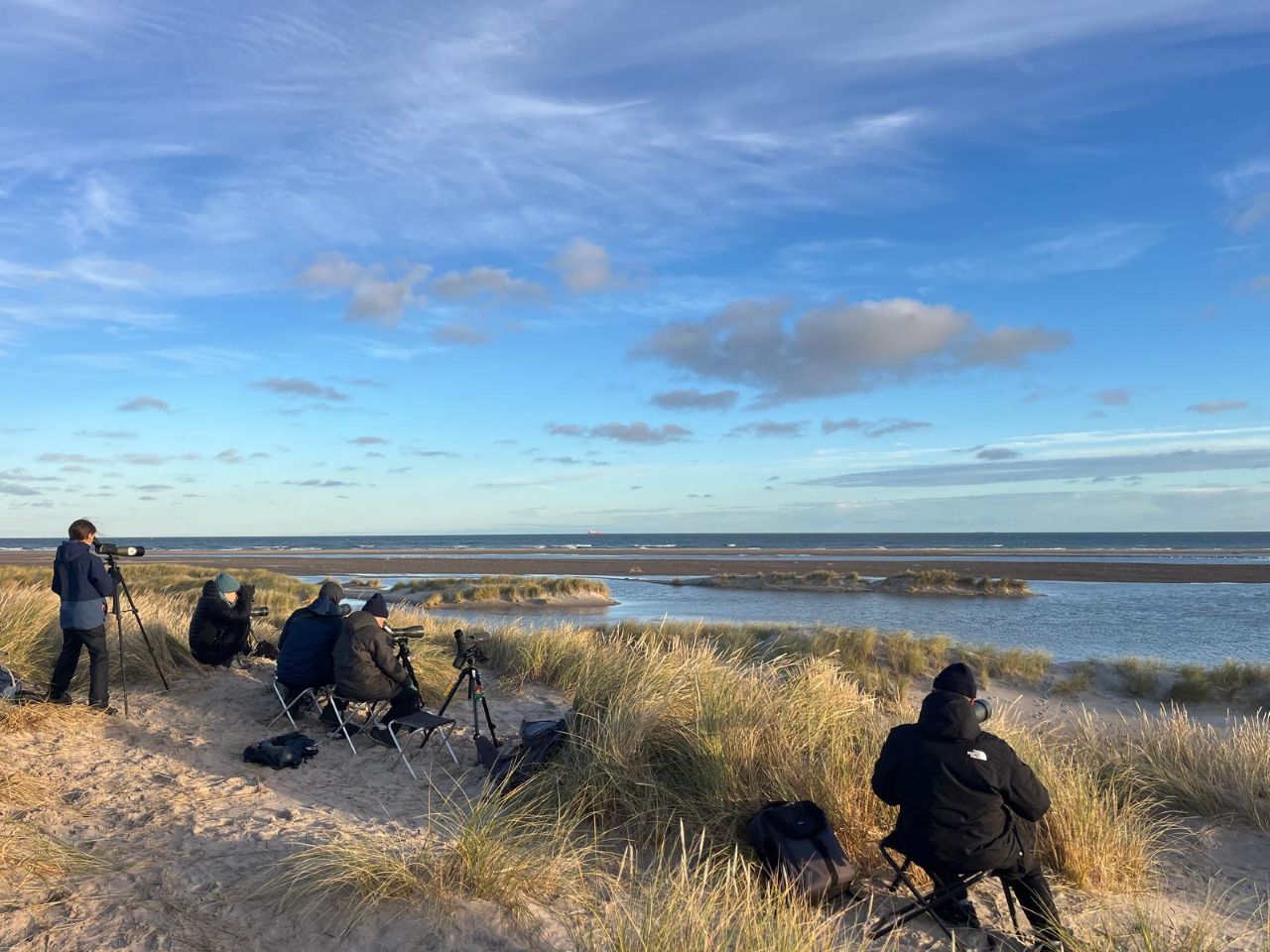
A sunny morning at World's End 3 for the migration count. Photo by Miles
Mara, Amira, and Lisa had a good morning at the ringing. It was rather windy, so they were only able to open half the nets yet still managed to catch 63 blue tits (blåmejse) with 88 ringed in total. Despite several busy blue tit rounds (Amira was ringing them nonstop for over an hour!) there were also some quiet rounds when Lone and Anton were able to ring. Today was the first time Anton has ringed, and he started off strong with several blue tits, a bullfinch (dompap), and a goldcrest (fuglekonge). After they closed the nets, 4 waxwings (silkehale) flew over. A nice highlight to end on!
In the afternoon, Florian, Lise, and Lone went out on a fulmar walk and despite having low expectations for what they would find, they had great success. They found 1 guillemot (lomvie), 1 fulmar (mallemuk), and 1 little auk (søkonge)! The fulmars are especially valuable for us to collect, because we are collaborating with Aarhus University to study the accumulation of plastic in fulmar stomachs.
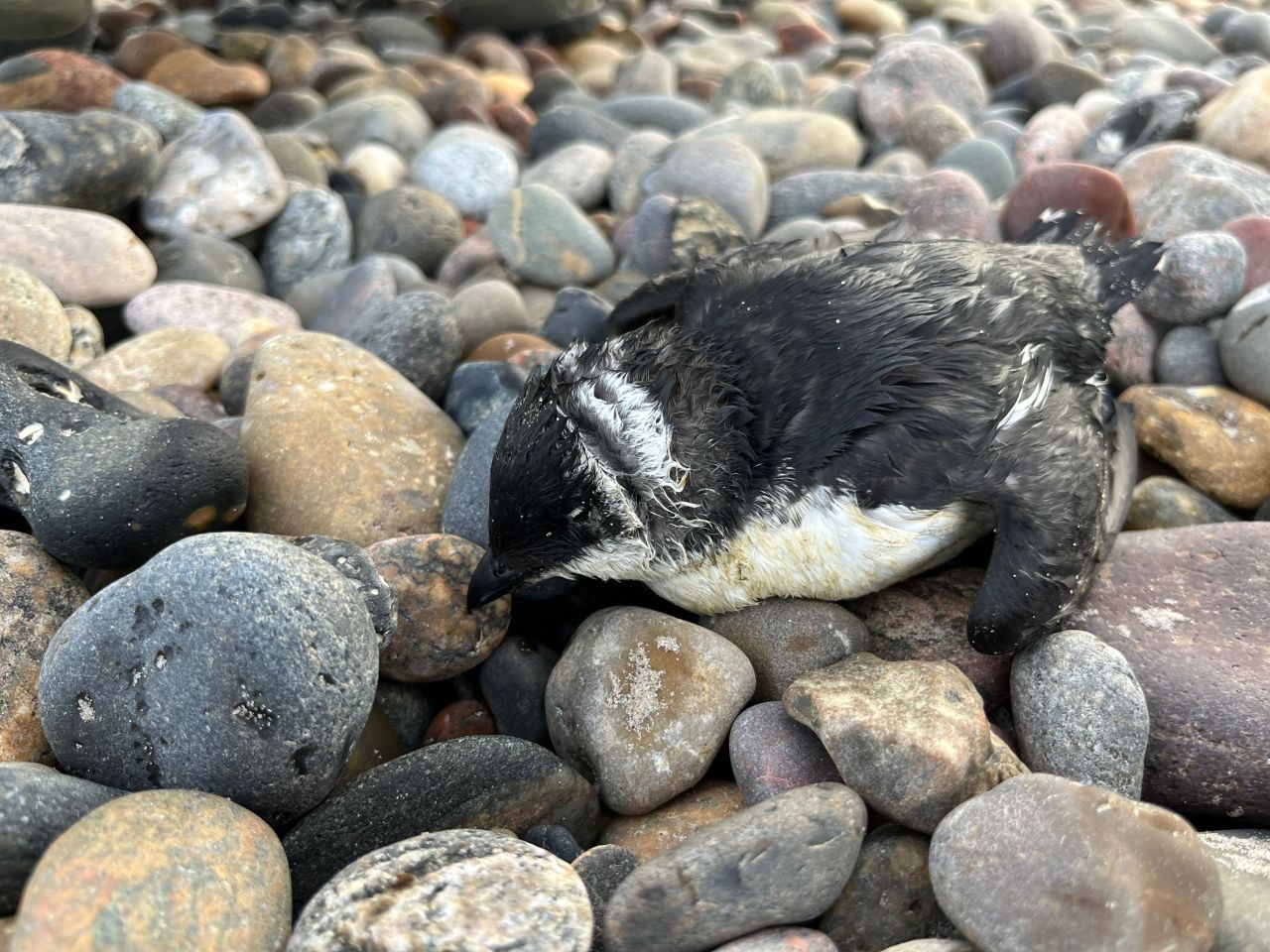
Dead little auk (søkonge) found during the fulmar walk. Photo by Florian
I had a quiet afternoon attempting to catch up on some work. I went for a lovely dip in the sea with Amira before she baked me a birthday cake. Lise cooked us some delicious vegetable soup and we opened up the bottle of blood orange soda we bought to celebrate the Pallas’s Leaf Warbler. This evening, while writing up the blog, I got a call from Gabriel, who sang the Swedish birthday song to me! He has been doing moss, mushroom, and lichen surveys in the mountains in northern Sweden since leaving here a few weeks ago and has been sending some really cool photos. It was so great to hear from him and a lovely end to a fantastisk birthday.
Ringing (Kabeltromlen):
Highlights from World’s End 3:
Today’s observations from the area can be seen here.
People: Mara Glane, Florian Hatt, Amira Nuseibeh, Miles Scheuering, Lise Mastrup, Ole and Anton, and our guests Lars and Lone
So many Søkonge
It was such a still morning at Kabeltromlen; all we could hear at dawn was bird call and the squeaky sound of our waders as Mara, Lise and I walked around opening up the nets. Mara had a dramatic start to the morning when she spotted a Hen Harrier bounce into the net in the first round, but unfortunately it bounced straight back out again. It made us wonder if we’d even have a big enough metal ring for a bird of that size! Maybe we should be more prepared just in case it stays in the net the next time…
It was Lise’s first morning ringing with us, and I really enjoyed having her as part of the team; her encouragement and offering of warm clothes when it got cold was very much appreciated! We ringed some lovely species including the highest number of Bearded Reedlings (Skægmejse) we’ve had in one day so far this Autumn, 15 in total! We release them all at once because of how social they are, so a highlight was when all of us including our helpers Anton, Ole and Lone, released a Skægmejse each! It was so magical watching them all fly away together calling excitedly!
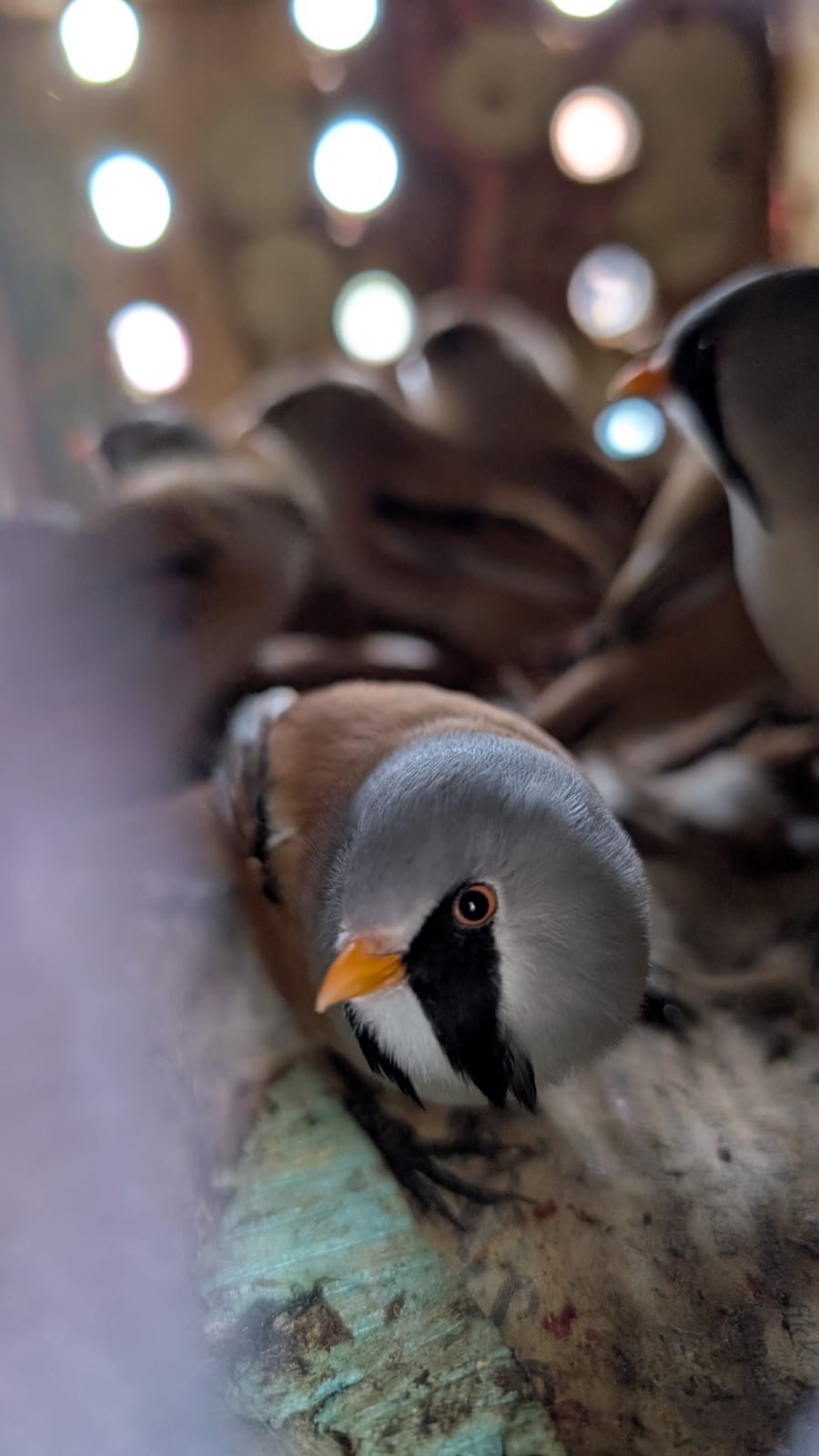
My own personal highlight was the two Firecrest, including one retrapped bird which we had initially caught and ringed last week. I really love how much energy these birds have despite only weighing around 5g; they’re constantly on the move, flitting through trees in search of insects. A big flock of tits and crests (mostly Blue Tits (Blåmejse)) in the last net round meant it was a long day for us, and we were ringing the last few birds as the sun started to set! But a fun day.
We had our Zello on whilst at Kabeltromlen and were amazed to hear 10 Little Auks (Søkonge) called out passing by World’s End 3. The observers (Miles, Florian and Janna) were having a fantastic morning! They had great views of both a Great Northern Diver (Islom) and a Black-throated Diver (Sortstrubet Lom) resting not too far away on the calm waters. A highlight was also two flocks of Waxwing (Silkehale) attempting migration out over the tip and then maybe realising the sea looked a bit scary, changing their minds, and heading back inland again. These birds seem to be having a good year compared to last year when there were only a handful over the whole Autumn.
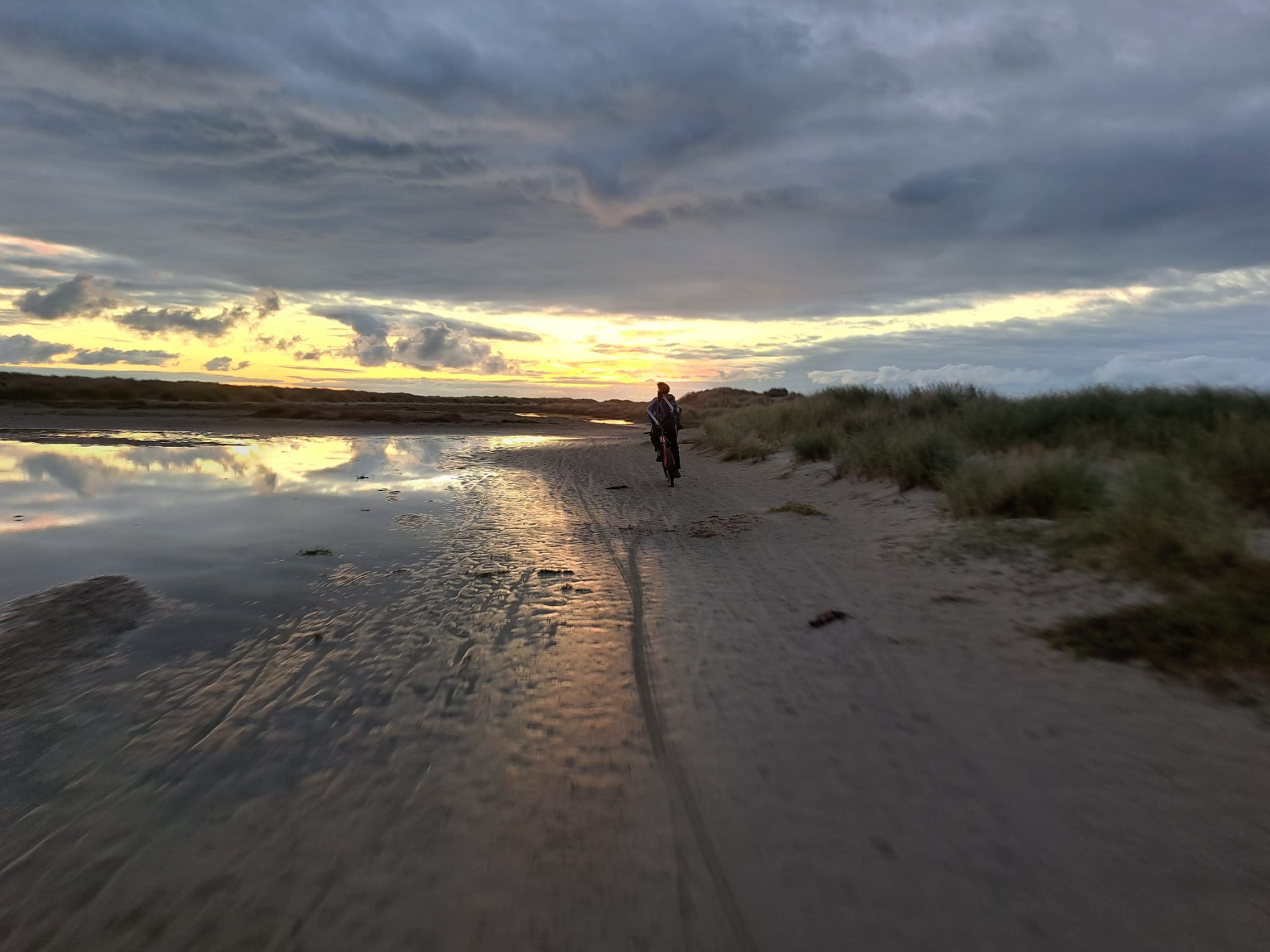
After their standard hours of migration count, Florian and Janna then continued birdwatching around the area for the remaining hours of daylight and found some nice birds. A metal-ringed Kingfisher (Isfugle) at Skarvsøen was probably the same bird we ringed at Kabeltromlen a month ago and keep re-sighting in the past weeks. They also heard a Little Grebe (Lille Lappedykker) and later saw a Great Grey Shrike (Stor Tornskade) too! Miles also had a pleasant visit to his favourite birding patch, the sewage plant behind the salmon farm, which today was filled with Long tailed tits (Halemejse) of both the pure white-headed northern and stripey-headed southern subspecies, how delightful.
Today’s observations from the area can be seen here.
People: Mara Glane, Florian Hatt, Amira Nuseibeh, Miles Scheuering, Janna Ouedraogo, Lise Mastrup, Ole and Anton, and our guests Lars and Lone
Another rare Sanger!
When we woke up today to check the radar, we saw long rain clouds hanging above Skagen. This meant neither ringing nor observing. On the other hand, it meant more time for us all with Sarah who left later in the day. We made a long Brunch with Pancakes and many different toppings. While we were finishing our pancakes, Miles read in the bird book about the identification of rare Phylloscopus Warblers. He talked about the Fuglekongesanger (Pallas´s Leaf Warbler) and was still on the page, when a zello came in. Fuglekongesanger at Skagen! We put our rain clothes on and headed out to the location. When we arrived there, there were already around ten people standing and searching for the warbler. We heard that the bird was only seen briefly and then disappeared again.
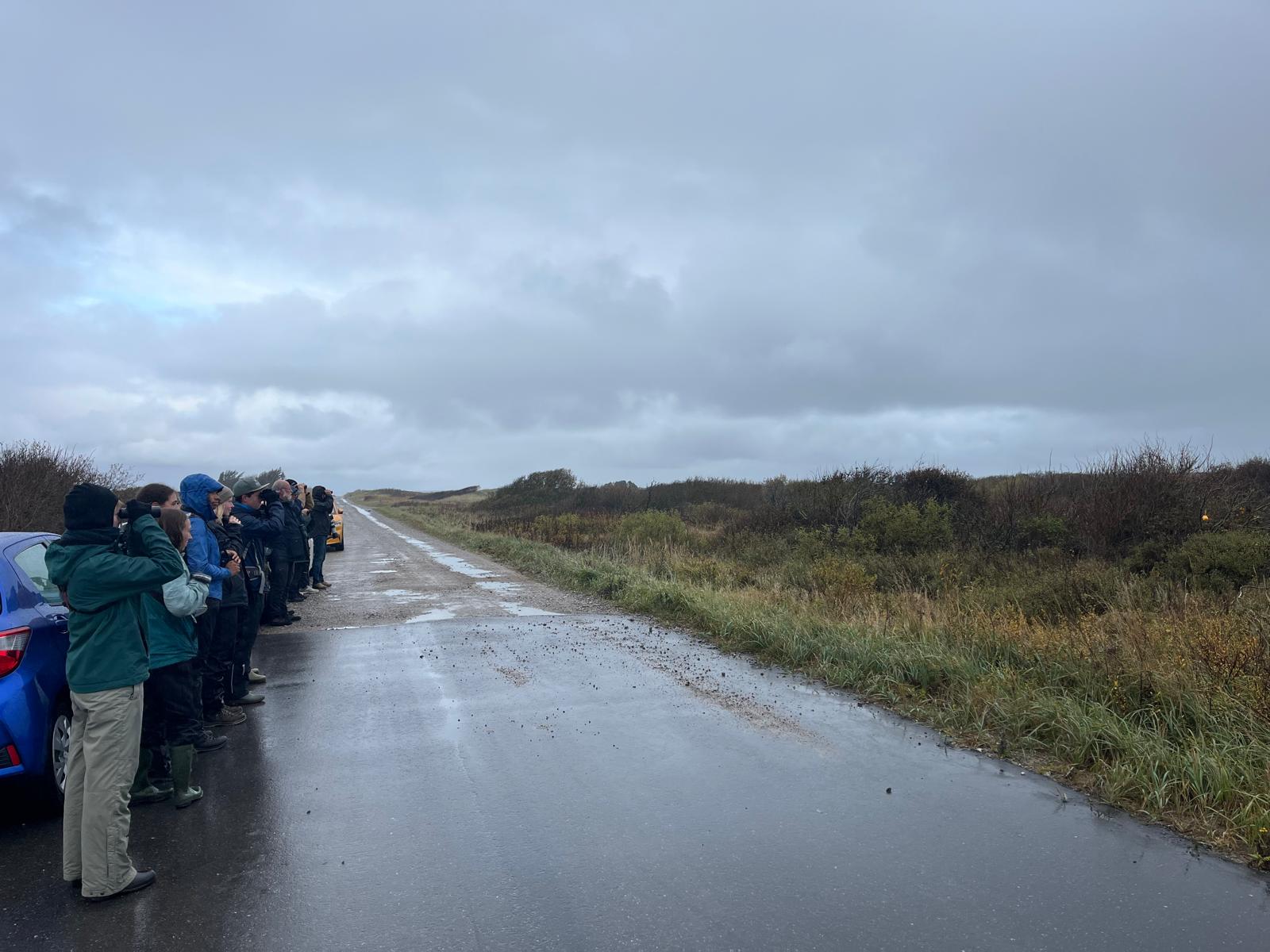 Line of twitchers looking out for the Fuglekongesanger
Line of twitchers looking out for the Fuglekongesanger
After a longer time, Mara exclaimed: there it is! We all raised our binoculars and could watch the beautiful bird rather close. Unfortunately, Miles had walked a bit around and did not see it. Anton only arrived after the warbler had shown up and some of the other birders also did not see it.
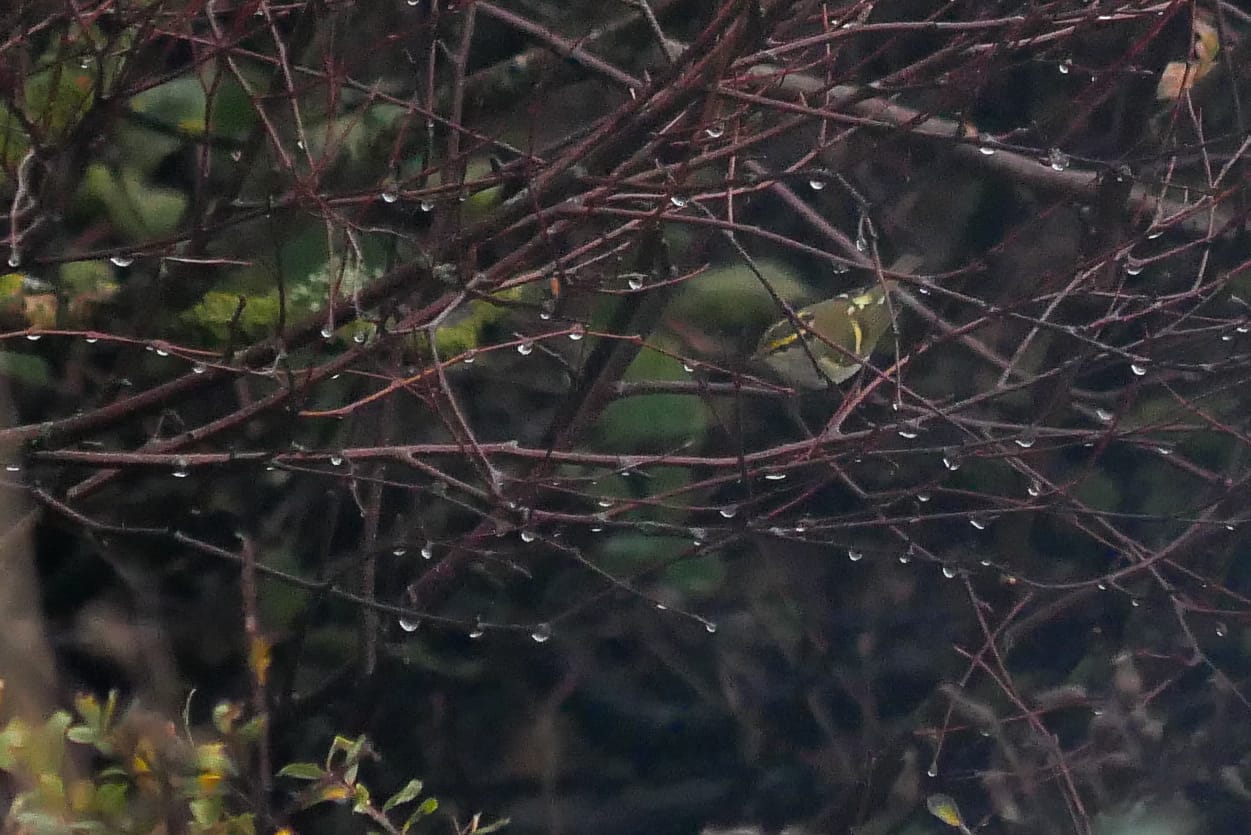 Anton even got a picture of the Fuglekongesanger
Anton even got a picture of the Fuglekongesanger
Then, it was time for Sarah to leave and get her luggage. Some time after that Flo spotted the warbler again. So luckily, Miles and Anton were able to see it too. We then decided to bike to the train station to say another time goodbye to Sarah. There we stood together under a roof to avoid the rain and wished her luck for a three-day ferry ride to the Faeroe Islands. She had been at the station for the last three months, so none of us arrived this autumn at the station without her being around. We will all miss her.
After lunch, the weather cleared up and some passerines showed up. Therefore, Flo and I went for a walk at Nedermose and later on to Skarvsøen. There we saw a very big flock of Grønsiskener (Siskins), two Bjergirisk (Twites) and some raptors. Meanwhile, Miles and Amira went out for a run and after that for a swim. After this and fixing an issue at the house, Amira, Mara and Lise went on the beach and were able to watch a flock of around 40 Snespurve (Snow Buntings). This motivated them to do some nightcatching. They just went out and said they will be back soon with some Snespurve.
Lise said, her first day here was different than expected. A chilled morning with pancakes and then the twitch instead of obs/ ringing. For me it was interesting to have a day up here without seeing a Razorbill or a Diver. We are now really looking forward for tomorrow. It seems to be a good time for nice warblers. Miles, the Oracle, is predicting a Sibirisk Gransanger (Siberian Chiffchaff) in the net.
Highlights from today
Ringing (Jennes Sø)
Ringing (Nordstjernevej-Nordlysvej-kvarteret):
Today's observations from the area can be seen here.
People: Mara Glane, Florian Hatt, Sarah Partridge, Amira Nuseibeh, Miles Scheuering, Janna Ouedraogo, Lise Mastrup, Ole and Anton, and our guests Lars and Lone
Flocks of Auks
This morning was too windy for ringing, so we all headed out as a family to migration count. We went to Nordstrand today and piled into our little nook with 14 of us in total observing. Therefore, we saw many birds with many highlights. In total we saw five Islom (Common loons), and some were quite close which was nice to see (some friends from my home in Massachusetts). We saw a nice assortment of ducks, including Fløjlsand (velvet scoter), Havlit (long-tailed duck), Hvinand (goldeneye), and toppet skallesluger (red-breasted merganser). The best highlight for me was the søkonge (little auk), which is very round and cute (and nearly as cute as the little auk is Florian getting excited about the little auk). The other highlight for everyone was the incredibly high number of Alks (razorbills); we counted over 10,000 in total!
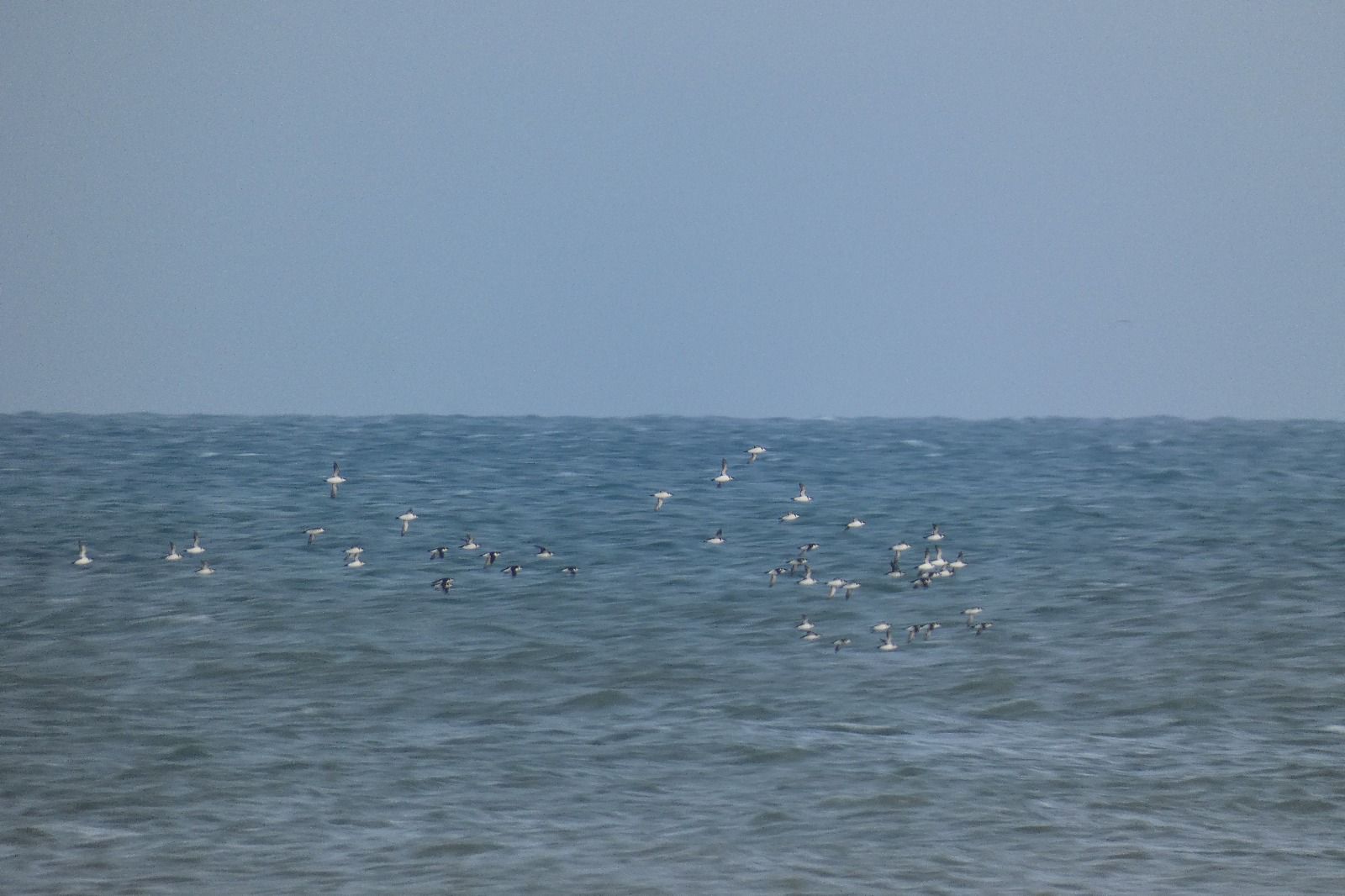
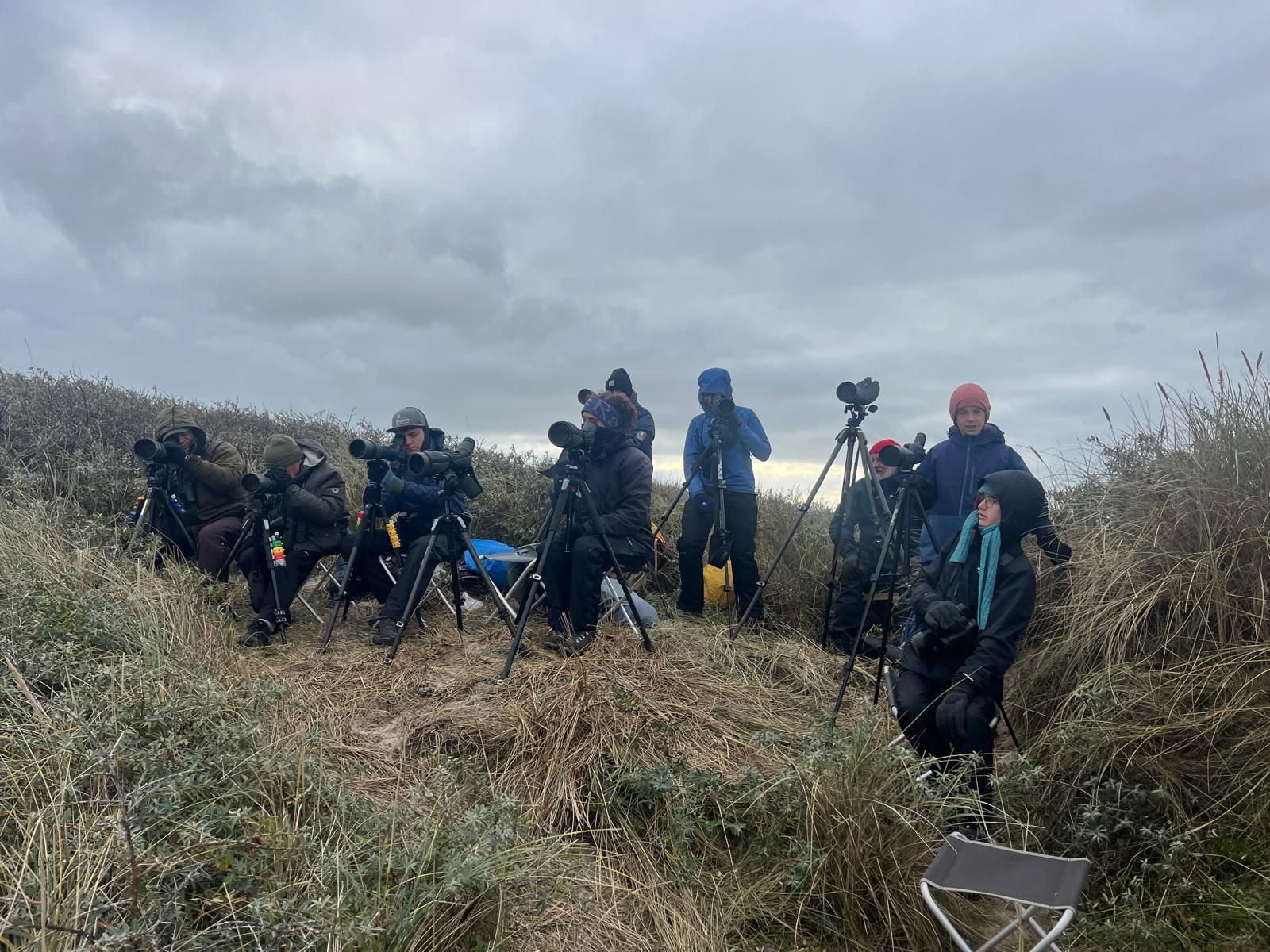
After the obs, Amira and I walked home together via Jennesø, and it was very cold and windy by then. Janna, Florian, Anton and Ole went birdwatching at Jennesø, and Amira had to quickly cycle to join them because she had accidentally stolen Ole’s bike key. While they were out, they saw another søkonge flying directly overheard toward Kabeltromlen. Little auks are the most abundant seabird breeding in the high Arctic, and they have the largest colonies of all the auk species. Fittingly, their Latin name, Alle alle, in German means “everyone everyone.”
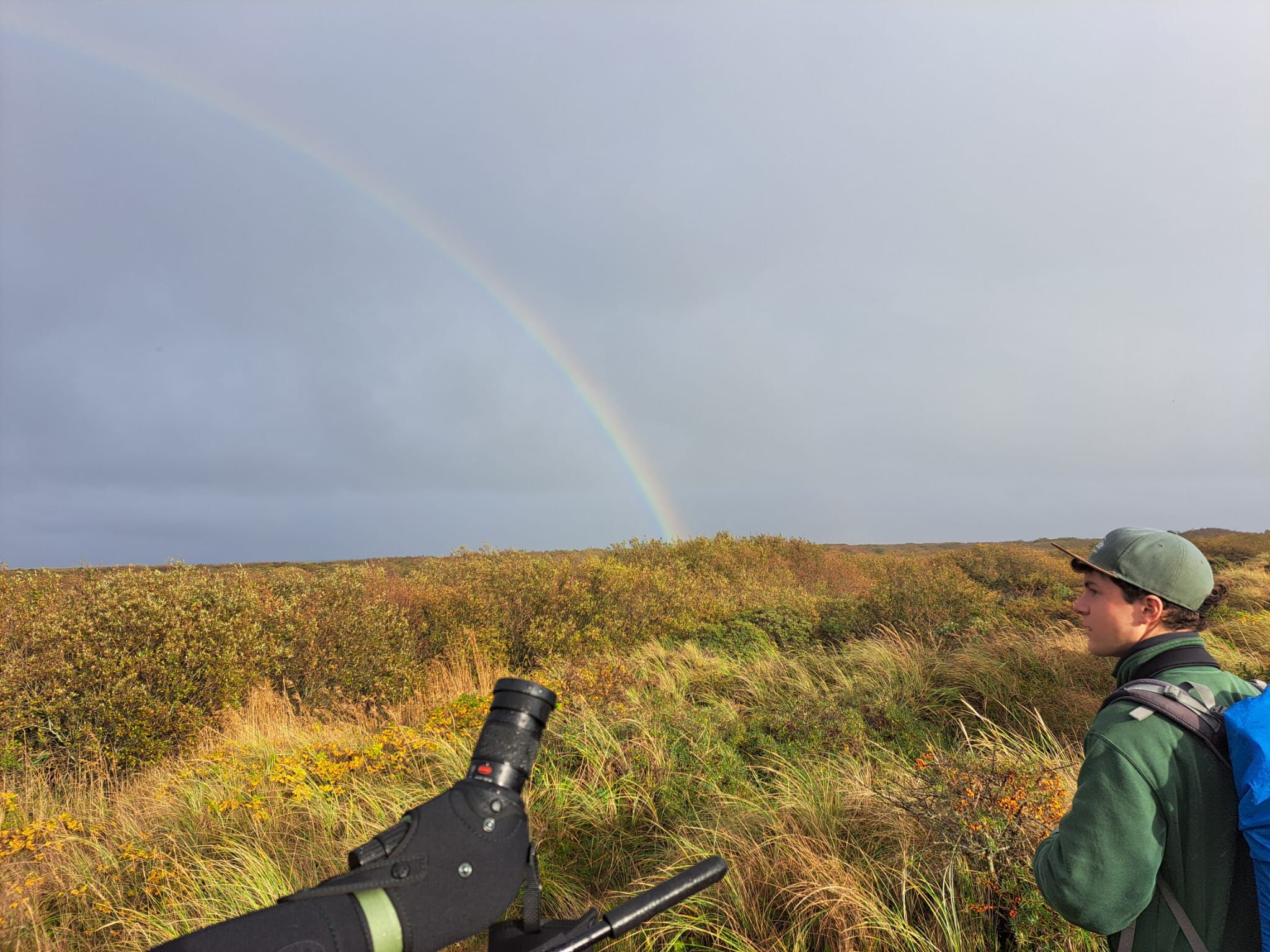
After lunch we welcomed our new volunteer Lise to the station, and then we had our Saturday cleaning. I spent some time putting my ducks in a row as I am leaving the station already tomorrow, too soon! I’m sure I will be seeing all my lovely new friends again sometime soon.
After a tasty meal cooked by Janna, we popped open some champagne to celebrate our 10,000 alks, my departure, and the Dusky warbler (Brun Løvsanger), so expertly ringed by Mara yesterday.
Tomorrow I will pack up my things and start over again, taking with me so much knowledge gained and wonderful friendships formed.
Highlights from observation:
Søkonge 4
Alk 10,932
Hjejle 258
Islom 5
Havlit 10
Today's observations from the area can be seen here.
People: Mara Glane, Florian Hatt, Sarah Partridge, Amira Nuseibeh, Miles Scheuering, Janna Ouedraogo, Lise Mastrup, Ole and Anton, and our guests Lars and Lone
From Dawn til Dusk
Hej!
As a proper day at Skagen Fuglestation it was full of rarities, cake and knowledge.
So the day started with Sarah, Amira and me cycling to Kabeltromlen and opening less than half of the nets due to strong southernly winds. But apparently those nets were enough to catch us some special birds - because every bird is special. We had some Redwings (Vindrossel), Blue Tits (Blåmejse), a Dusky Warbler (Brun Løvsanger) and a Fieldfare (Sjagger). 'Only' 22 birds in total, as we had to close early because of a heavy rain shower.
Over at the Observation, Miles, Florian and Janna had a decent observation morning, with a Great Northern Diver (Islom) and a Water Pipit (Bjergpiber). And of course some rain to brighten the mood. In the second hour, after checking their messages, they all decided to come and visit us ringers at Kabeltromlen today. How nice!
Okay, just kidding, I am of course not just gonna brush over the rarity we caught and ringed today :) The Dusky Warbler (Brun Løvsanger) we had in the net today was not just one of many birds, it was truly special, as the species normally breeds in eastern Asia. It is the first one ever ringed in Skagen and the third record for the area. With a fat score of 7 it was ready for the ringing, measurements and some photos by excited birders from the area. It attracted a little crowd, all awing at this rarity. What a beautiful brown bird!
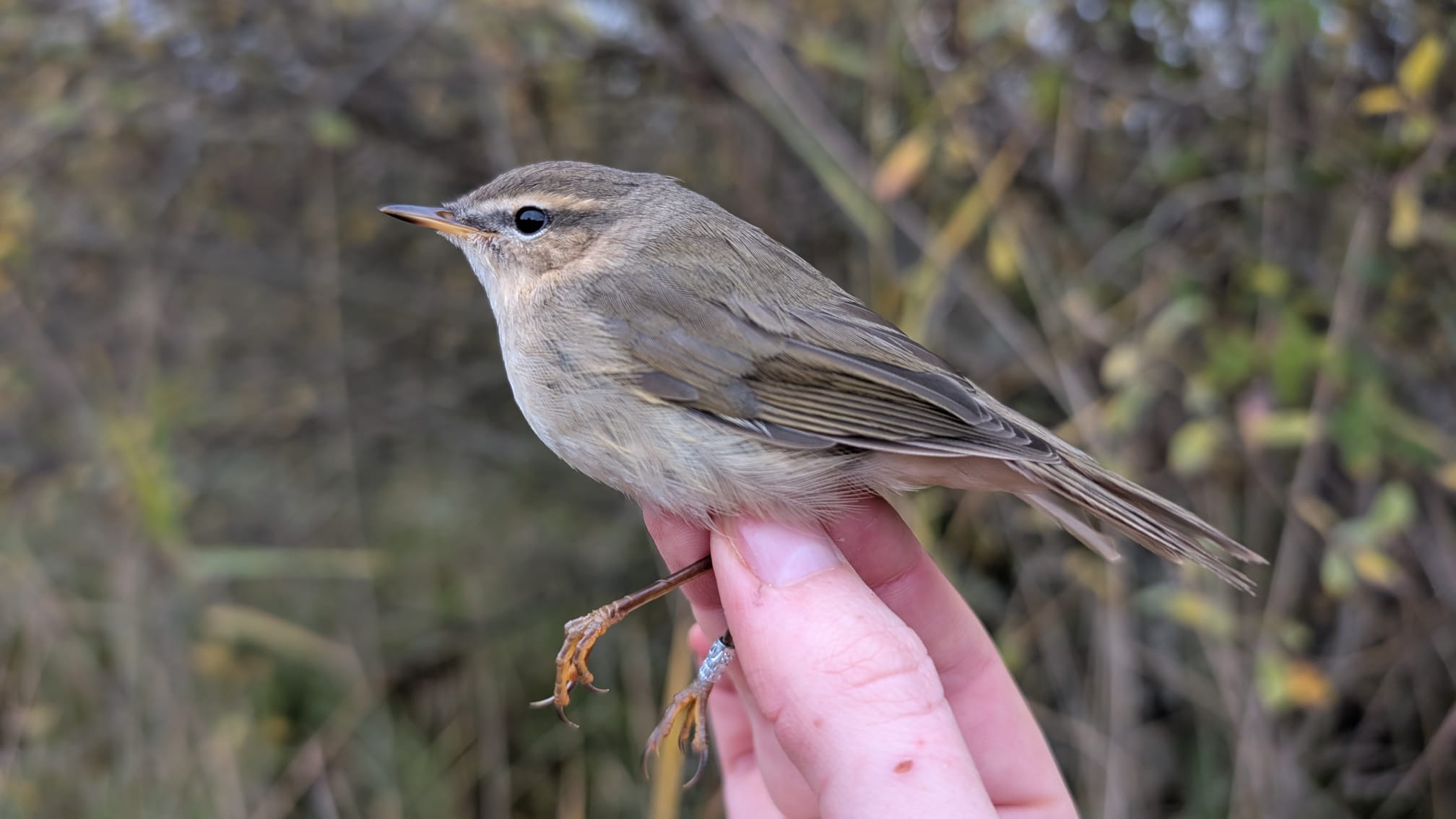
Dusky Warbler (Brun Løvsanger)
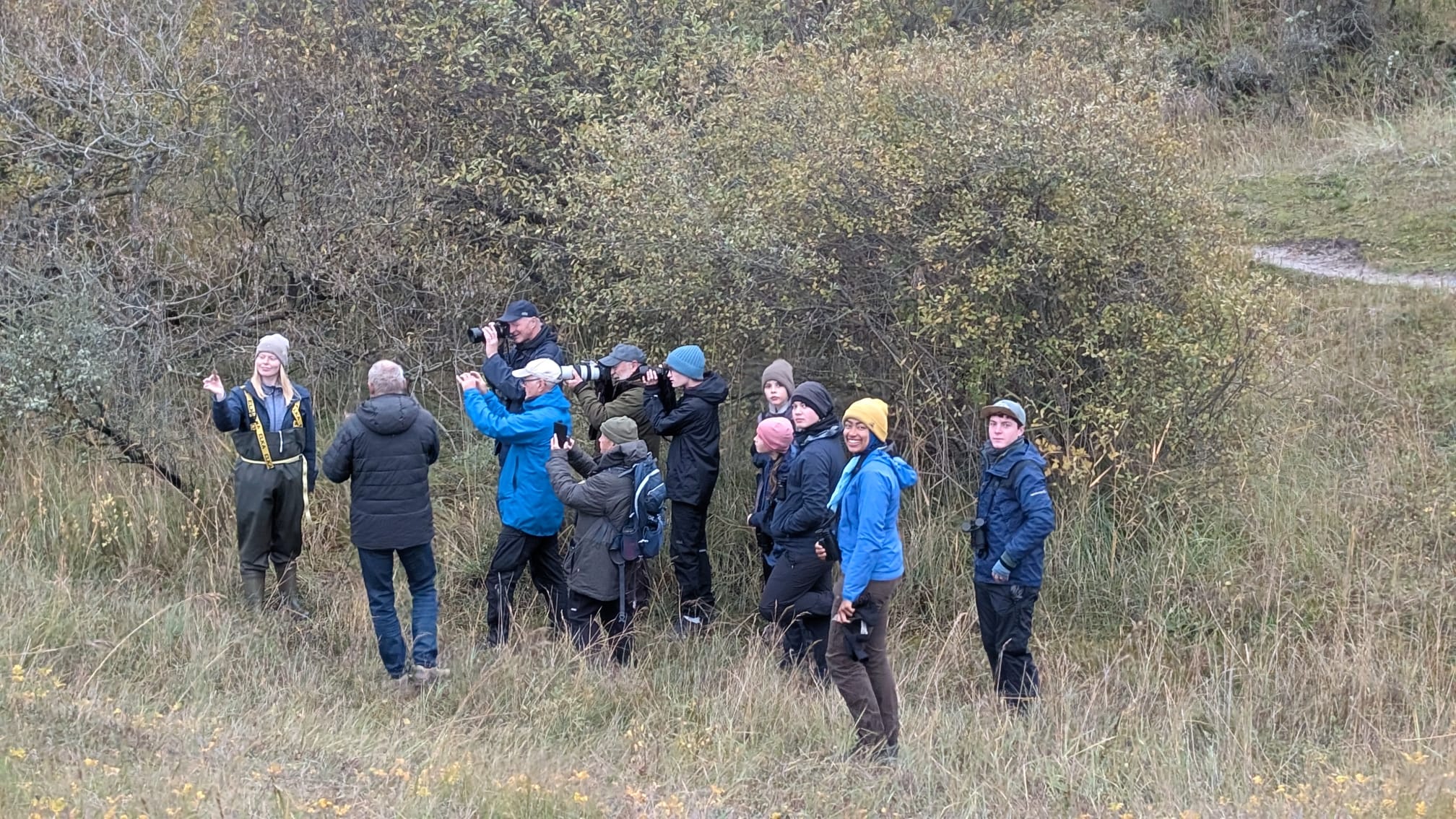
Famous Dusky Warbler
The unforseeable rain put a sudden stop to the ringing after that and we went back to recover from the adrenalin rush. The observers went back out to get a little more wet (and look for more rarities of course) before coming back to the station. After lunch, everyone went on their little afternoon walks, with Miles and Sarah ending up in a pub to celebrate the Dusky Warbler with a beer. I joined them later to pick them up for a visit to a bakery. I prefer cake over beer to celebrate! Amira relaxed a bit in the woods, together with some Goldcrests (Fuglekonge) and Florian and Janna did some nice birding at Nordstrand and Skarvesøen. They were kinda hoping to see the Grey Phalarope (Thorshane) that Knud Pederson saw this morning, but no luck on that.
After our evening meeting we had a lovely and interesting session from Sarah on Storm Petrels (Lille Stormsvale), where we gained some knowledge on their special way of living and the knowledge gaps that are still there about those mysterious birds.
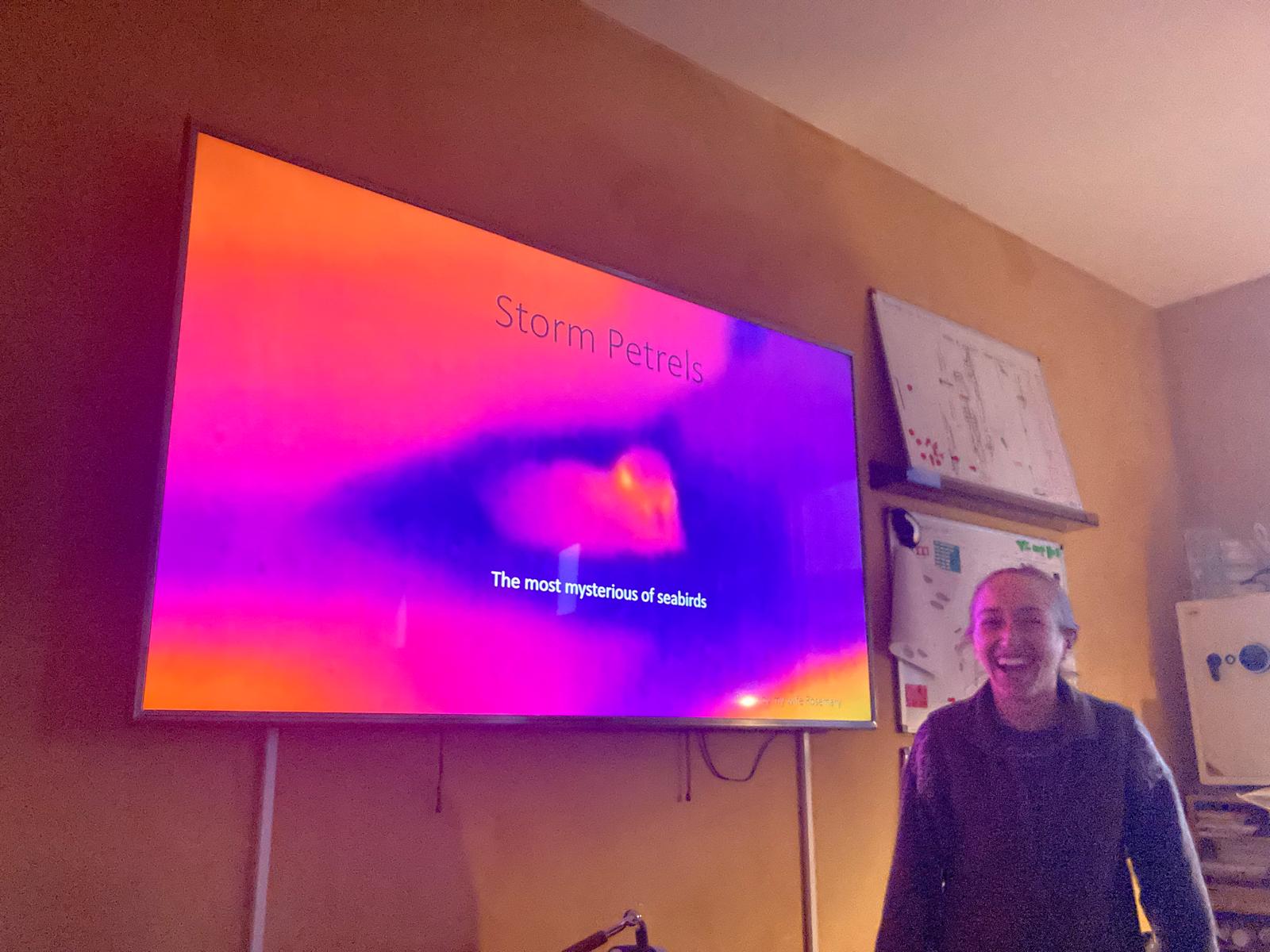
Sarah presenting her talk about the mysterious Storm Petrels (Lille Stormsvale)
Ringing (Kabeltromlen):
Vindrossel 4
Sangdrossel 1
Sjagger 1
Rødhals 1
Gærdesmutte 2
Blåmejse 7
Munk 1
Stor Dompap 1
Fuglekonge 3
Brun Løvsanger 1
Total: 22
Highlights from the observations:
Great Northern Diver (Islom)
Water Pipit (Bjergpiber)
Today’s observations from the area can be found here.
People: Mara Glane, Florian Hatt, Sarah Partridge, Amira Nuseibeh, Miles Scheuering, Janna Ouedraogo, and our guest Lars.
A Russian Spy

Blue Tit with a Russian ring!
After some rainy mornings, it was a nice change to have a good sunrise today as we opened the nets at Kabeltromlen. We (Mara, Sarah and I) were a little nervous and excited that we would again catch lots of Great Tit (Musvit), but only caught one today, and instead there were lots of Blue Tits (Blåmejse), almost 50 in total! Normally, we would find this a bit annoying because Blue Tits especially love to bite our fingers in exactly the places that hurt the most, but today we were joined by an extra special visitor, a Russian Blue Tit! It had a ring inscribed with MOSKVA, meaning it was first ringed somewhere in Russia. We’re looking forward to finding out exactly where it’s come from, but also a bit suspicious that it arrived in the nets on its own (whereas most Blue Tits arrive in flocks). Could it be a Russian Spy?! The rest of the ringing morning was quite quiet except for a Firecrest (Rødtoppet Fuglekonge) during the last net check, a very handsome male bird.
A stunning male Firecrest
The observers (Florian and Miles) had a strong start to their morning with over four Great Northern Divers (Islom), a little Auk (Søkonge), a flock of over Coal Tits (Sortmejse), and 4000 Razorbills (Alk), as well as some good numbers of Snow Bunting (Snespurv) on the beach, and five Whooper Swans (Sangsvane) passing overhead. Migration slowed down later on in the morning and they were glad to escape the cold and wind and come home to a delicious cake gifted to us by our guest Lars (thank you!). It was so delicious that it’s almost disappeared completely already. We then visited the lighthouse shop to peruse the selection of bird-themed bits and bobs, and Mara bought some beautiful bird posters.
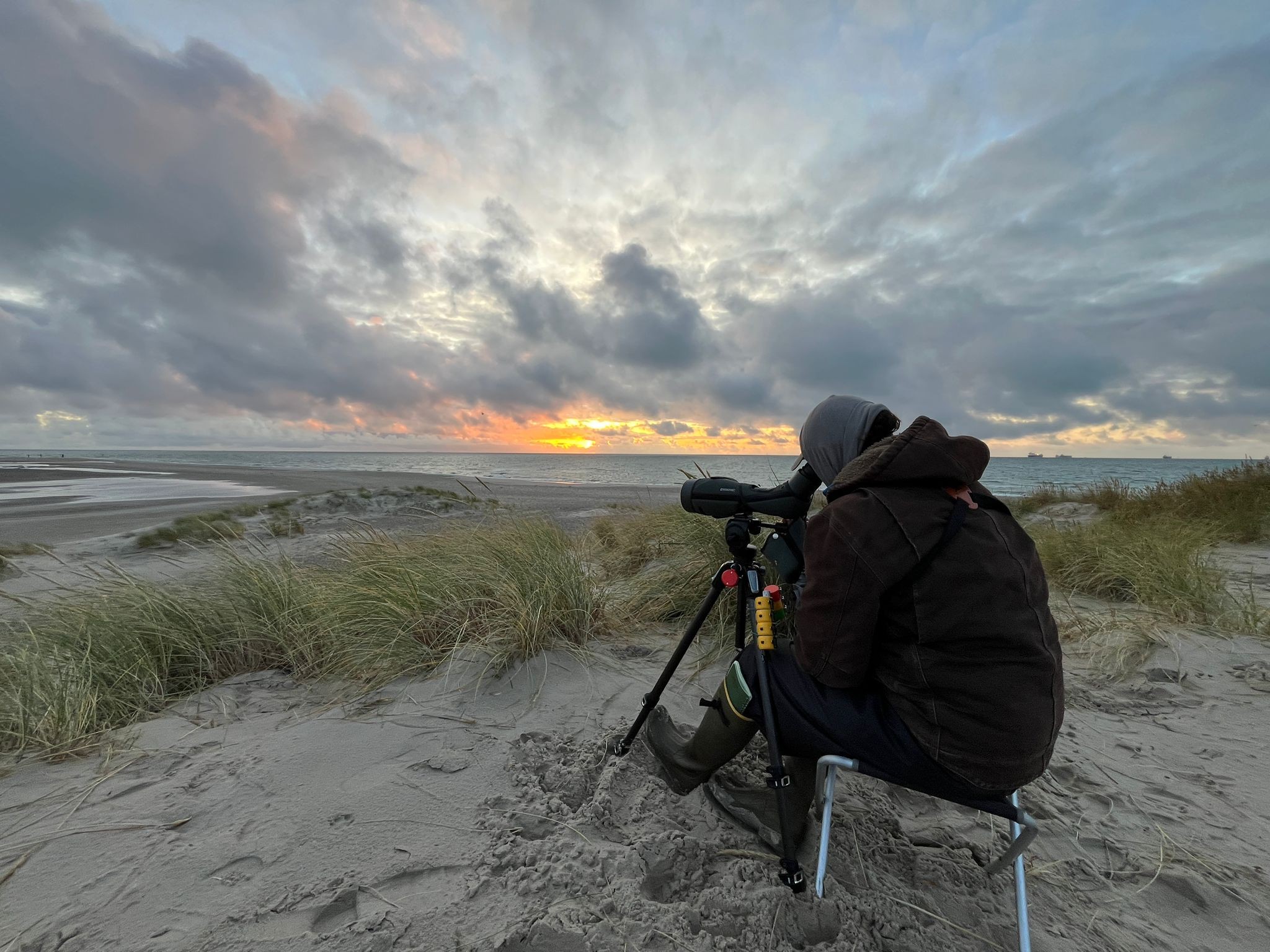
Miles observing at World's End 3
After a laughter-filled group lunch, we all parted ways for a couple of hours. Florian went out birdwatching in town and spotted a Hawfinch and a flock of Brambling, and then bumped into Miles in the industrial area, so they joined forces to bird their way around the area. Janna also returned to the observatory this afternoon, only four weeks after she left! It’s brilliant to have her back and she was so excited to be here again that she immediately went out birdwatching too!
Meanwhile Mara, Sarah and I received a call from Simon that our new Kabeltromlen (ringing table) had been delivered and that we should take it to the ringing site. With rain forecast to arrive in the next hour, we hurried out to find it and, surprisingly, had a lot of fun rolling it down the track. We tried to recruit Florian and Miles to help us by pretending that we’d seen a mystery pipit, but they didn’t fall for it. We were asked if it had a red rump and when we said yes, Florian sneakily exclaimed that there wasn’t any pipit that fitted that description. Oops.
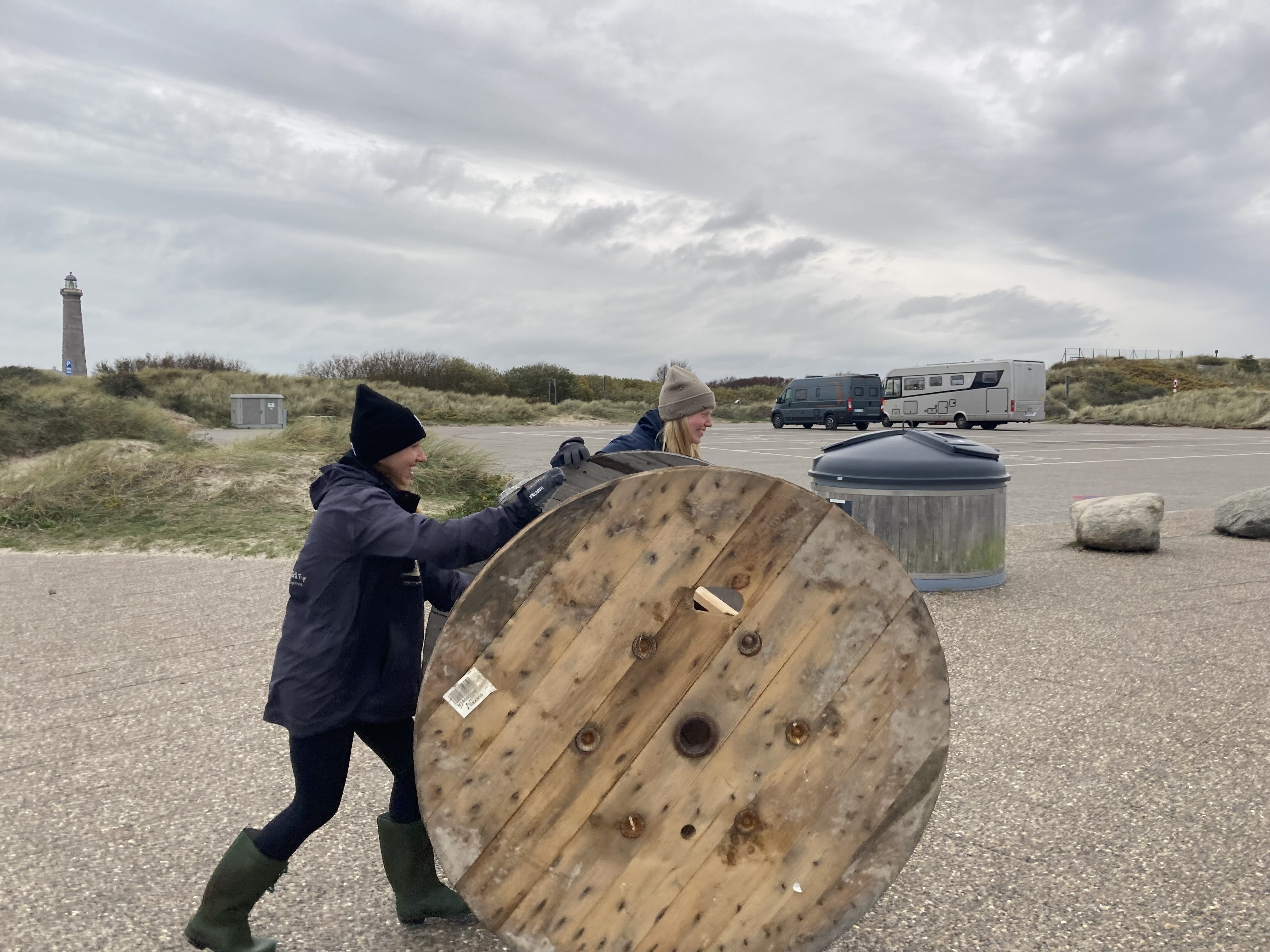
Rolling the new Kabeltromlen to the ringing site
After our evening meeting, Mara cooked us a delicious dinner of potato and broccoli tray bake whilst Mara, Janna and Florian educated me on the best German pop music. Now, we’re getting ready for a movie night; we’re watching the second Pirates of the Caribbean movie!
Ringing (Kabeltromlen):
Highlights from World’s End 3:
Today’s observations from the area can be found here.
People: Mara Glane, Florian Hatt, Sarah Partridge, Amira Nuseibeh, Miles Scheuering, Knud Pedersen, and our guest Lars.
I've Never Seen So Many Great Tits
The weather has been unsettled all week and yet again it was too rainy to start the count or the ringing at the usual times. We enjoyed having some extra time, but the rain let up around 9 and Florian and I were able to head to World’s End 3. There had been some discussion about whether to count at Nordstrand, where Knud was going, or back to World’s End 3. Nordstrand is very good in southeastern winds, as it provides good shelter and birds migrate very close to the shore. World’s End 3 is much more exposed, so you can see more but there is more wind. It does provide better opportunities to count passerines and there are more birds resting on the shoreline.
We were also interested to see how the two sites would compare in the same conditions. Just as we were getting on our bikes, we heard Knud call out White-billed Diver (Dansk: Hvidnæbbet Lom, American English: Yellow-billed Loon). This is quite a nice bird, though we have seen a couple recently. Activity was good as soon as we arrived at World’s End 3, and we saw a large loon that could have been a Great Northern Diver (Dansk: Islom, American English: Common Loon), though we didn’t see it well enough to be sure. However, in the next hour another large diver (lom) flew by and we were able to identify it as a Great Northern (Islom)! There were also many Snow Buntings (Snespurv) flying around and resting on the beach. With so many around we were both carefully checking the flock for Lapland Buntings (Dansk: Lapværling, American English: Lapland Longspur). While they were flying we noticed an all-brown bird, but unfortunately the flock was flying out over the sea and we lost sight of it. A bit later, Florian pointed out a scoter (sortand) that had a lot of orange on the bill, like a Black Scoter (Amerikansk Sortand). Right after, I noticed the flock of Snow Buntings had returned to the beach. I quickly scanned them and was able to find the brown one, it was a Lapland Bunting! They used to be quite common here, but have gotten increasingly rare in recent years, so it is quite exciting to see one!
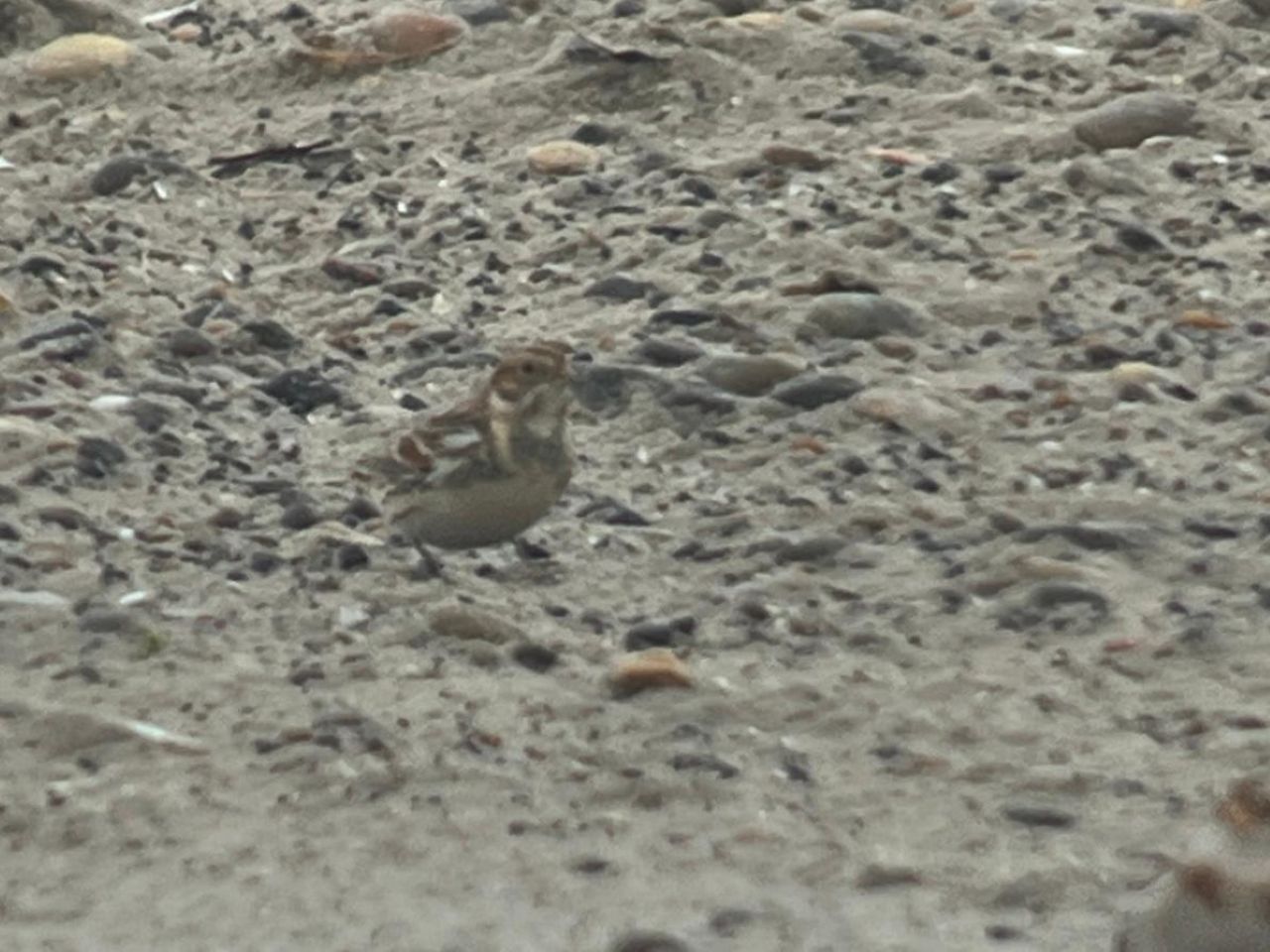
Lapland Bunting (Dansk: Lapværling, American English: Lapland Longspur) at Grenen. Photo by Florian
The ringers (Sarah, Mara, and Amira) had a slow start to the morning. They tried to open nets a bit before 9, but it was still raining and they turned back before they reached the bikes. Despite thinking they would not catch very much, they went back out later and were able to open most of the nets. It ended up being very worthwhile, as the weather held for most of the day and they caught a crazy number of Great Tits (Musvit)! There were 63 in total, perhaps the best day for them since the start of the station. They also caught 49 Blue Tits (Blåmejse) including one that had a fat score of 8! This is exceptionally high, because the more fat birds amass, the more they have to carry around, potentially affecting their flight and making predation more likely.
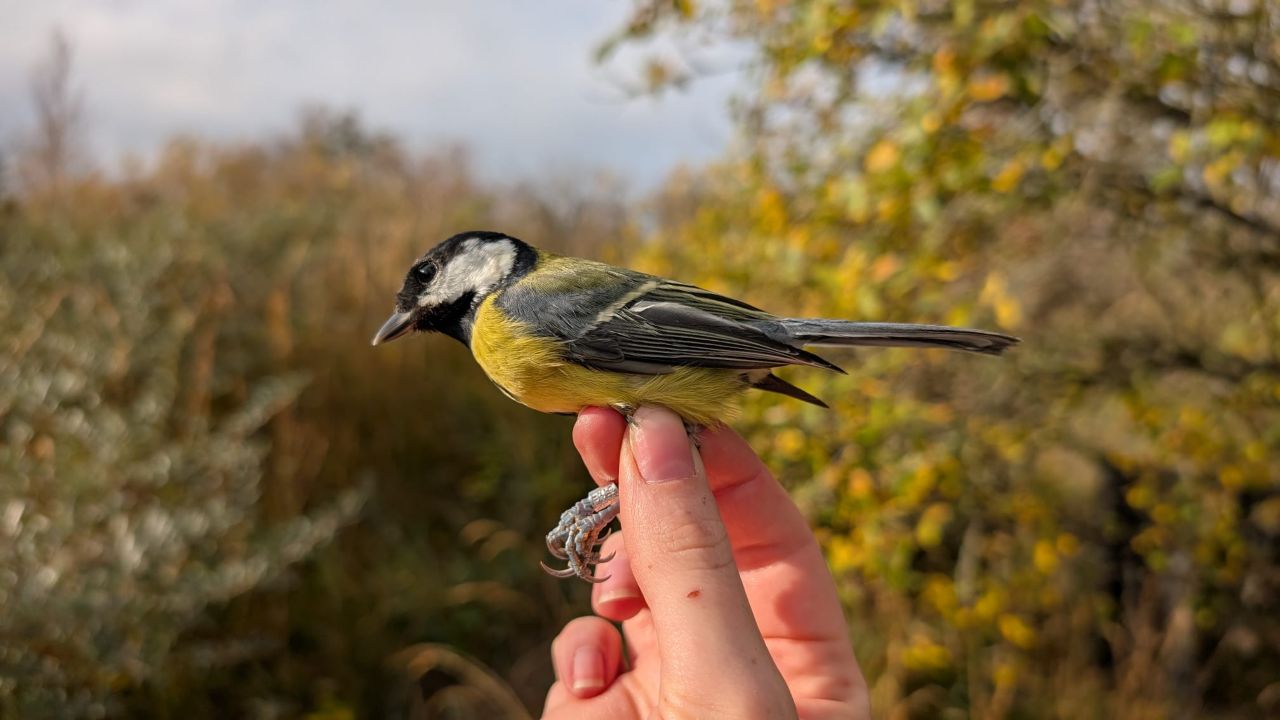
One of many Great Tits (Musvit) ringed at Kabeltromlen today. Photo by Mara
During the count, Florian and I saw a strange-looking pipit fly by, so afterward, we went to look for it in the brush west of World’s End 3. We were just looping back when we got a call from the ringers that they could use some extra help and that they had caught a Siberian Chiffchaff (Sibirisk Gransanger). This is a subspecies of Common Chiffchaff (Gransanger), which breeds in Taiga from the Ural Mountains eastward in Russia. The station generally catches at least one per year and they are maybe the least interesting of the ‘Siberian birds’ but still cool to see!
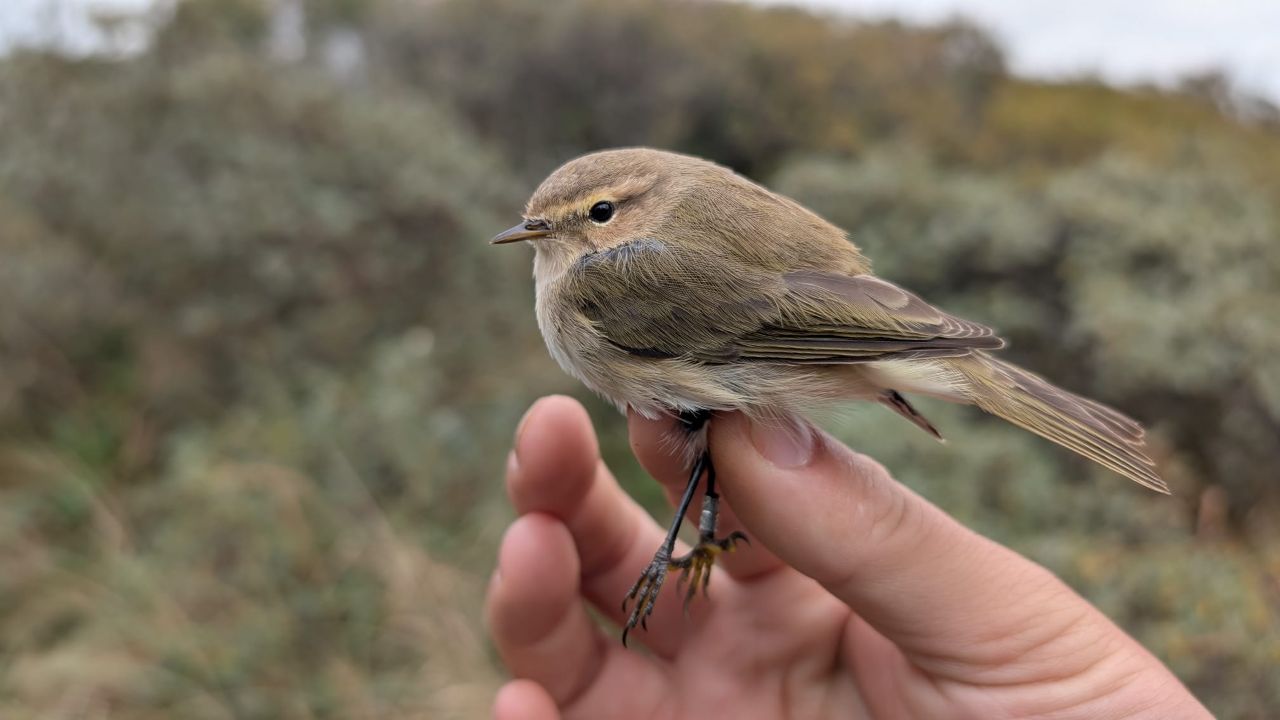
Siberan Chiffchaff (Sibirisk Gransanger) ringed at Kabeltromlen today. Photo by Mara
After getting back from the ringing in late afternoon, Amira cooked us a tasty gnocchi dinner, while Sarah and I took a refreshing dip in the sea. Later in the evening, Sarah and I went out night catching and had several close run-ins with Snow Buntings before eventually catching a Jack Snipe (Enkeltbekkasin). The Snow Buntings were quite flighty, but it was exciting to see them and gives us hope of catching one in the coming days.
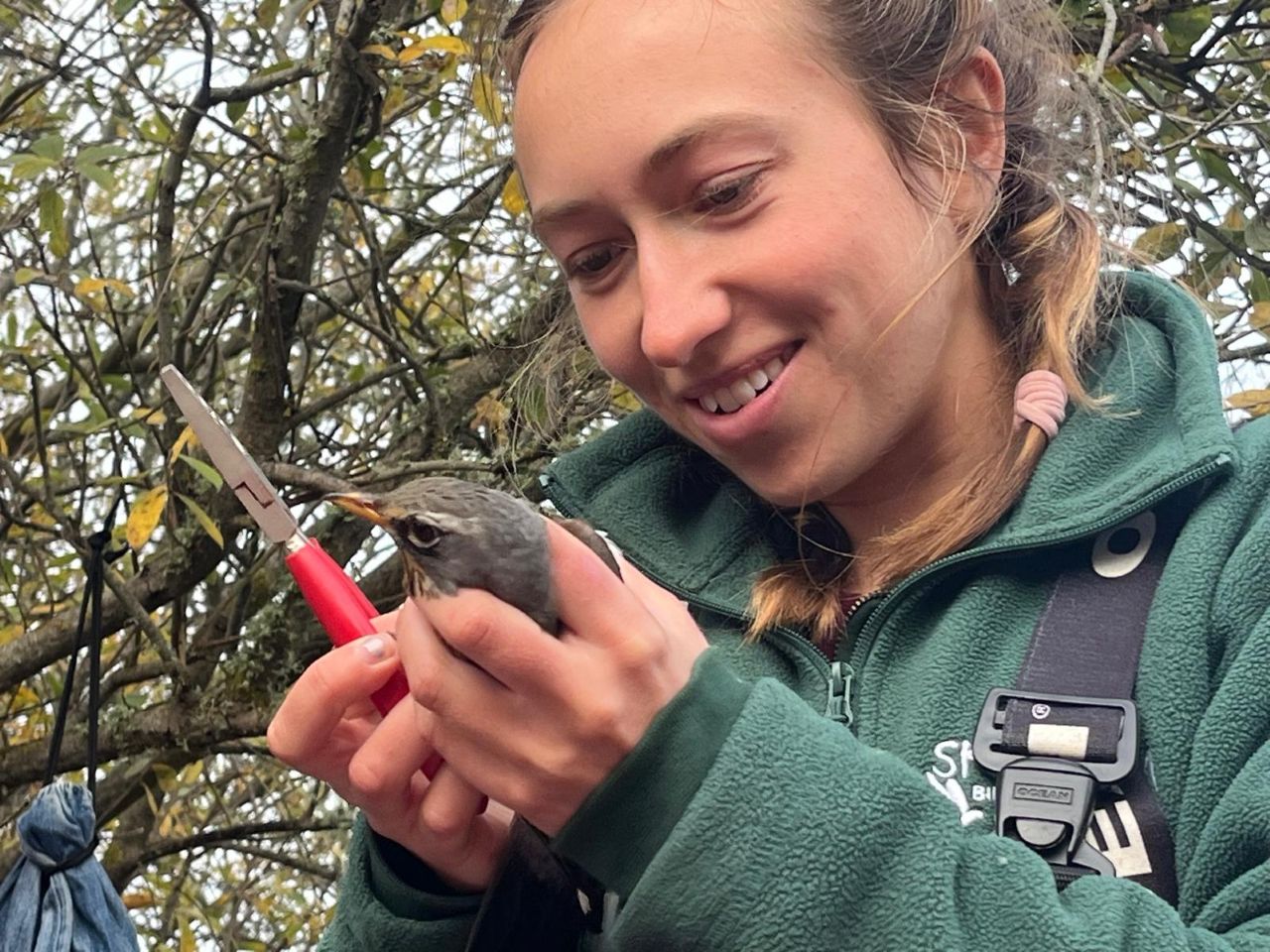
Sarah ringing a Fieldfare (Sjagger) this afternoon. Photo by Miles
Ringing (Kabeltromlen):
Highlights from World’s End 3:
People: Mara Glane, Florian Hatt, Sarah Partridge, Amira Nuseibeh, Miles Scheuering, Knud Pedersen, Simon S. Christiansen and our guest Lars
Ivory Birds
When my alarm clock rang today, the first thing I did was check the weather radar. As it would rain a while longer, I lay down again for a short while. Later, however, we were all awake and raindrops were still falling outside. A relaxed brunch then prepared us for the day ahead. Amira, Sarah and I went again to the migration count at Nordstrand. Knud had arrived a little earlier and had already counted the first birds. There weren't too many birds migrating, but an adult Little Gull (Dværgmåge), some Auks (Alkefugle) and Kittiwakes (Ride) were of course great to see. Suddenly, a big Diver (Lom) approached from the west. I immediately focused on identifying the colour of its bill. However, I had difficulties even seeing the bill, what was already a very strong indication of a White-billed Diver (Hvidnæbbet Lom). It was so pale that it blended into the background. Only when the bird came close enough, we could see the white-yellow bill and the colouration of the neck to be sure it was one indeed! En fantastisk fugl! We also discussed whether the name Yellow-billed Loon or White-billed Diver makes more sense in terms of bill color. Or how about Ivory-billed Diver? It would certainly sound cool!
In the meantime, Miles, Mara and Simon had brought new pallets to Kabeltromlen. In just a few days we will receive a new cable drum and we want to put it on pallets so that it doesn't get weather-beaten as quickly as the old one!
In the afternoon, we all drove to the harbour together to see if we can find some rare gulls. What about an Ivory Gull (Ismåge) for example? Simon told us about one that showed up several years ago in Denmark together with a Snowy Owl (Sneugle). We would of course take this combination in the harbour of Skagen! But for today no Snowy Owls or Ivory Gulls showed up, but we were still able to observe a Red-throated diver (Rødstrubet Lom), a few Guillemots (Lomvie) and a Rock pipit (Skærpiber) from up close!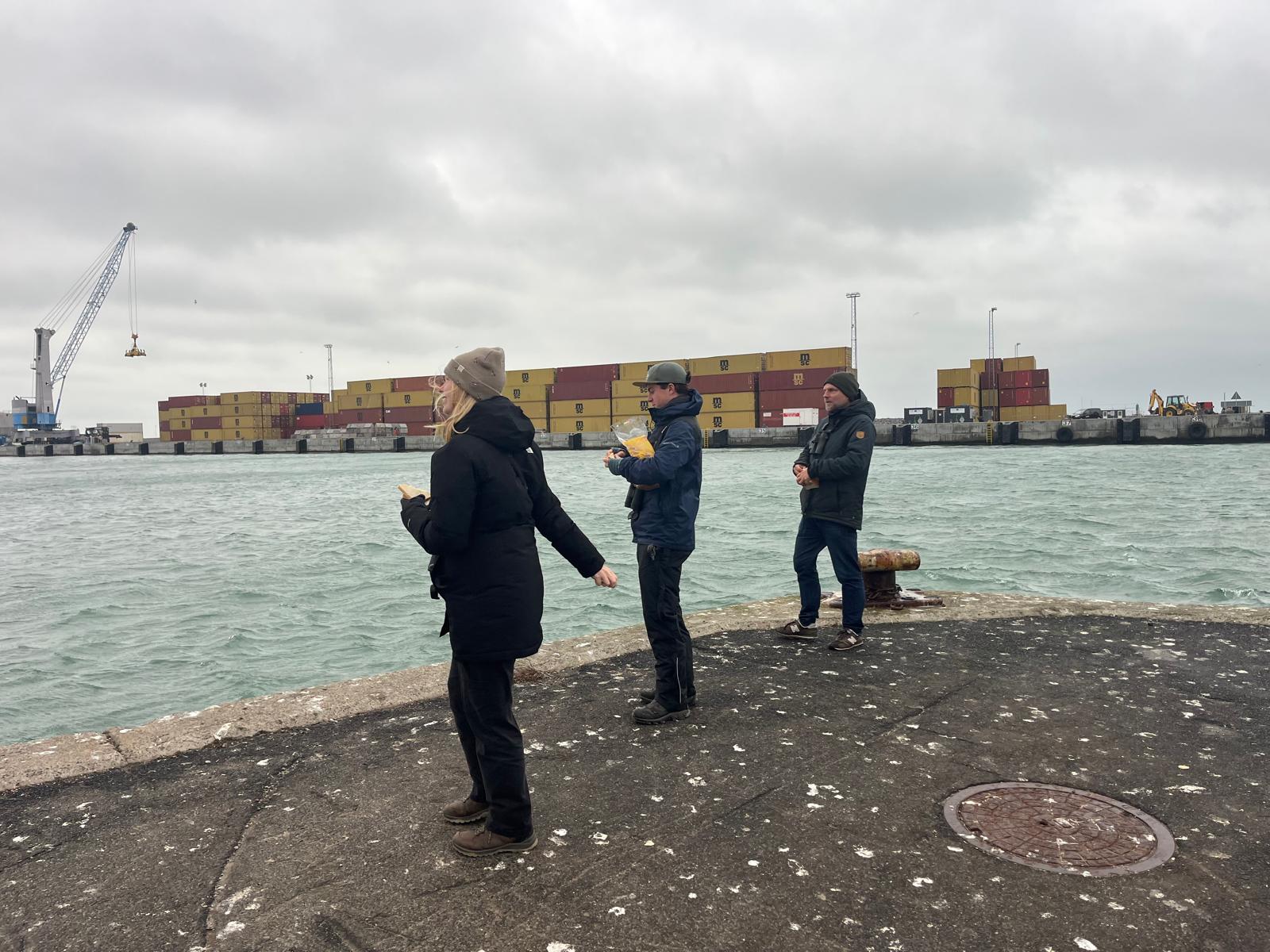
Feeding gulls in the harbour
In the evening we were doing various indoor tasks and enjoyed a tasty dinner, that Miles made for us!
No ringing today
Highlights from Nordstrand
Hvidnæbbet Lom 1
Today’s observations from the area can be found here
People: Mara Glane, Florian Hatt, Sarah Partridge, Amira Nuseibeh, Miles Scheuering, Knud Pedersen, Simon S. Christiansen and our guest Lars
